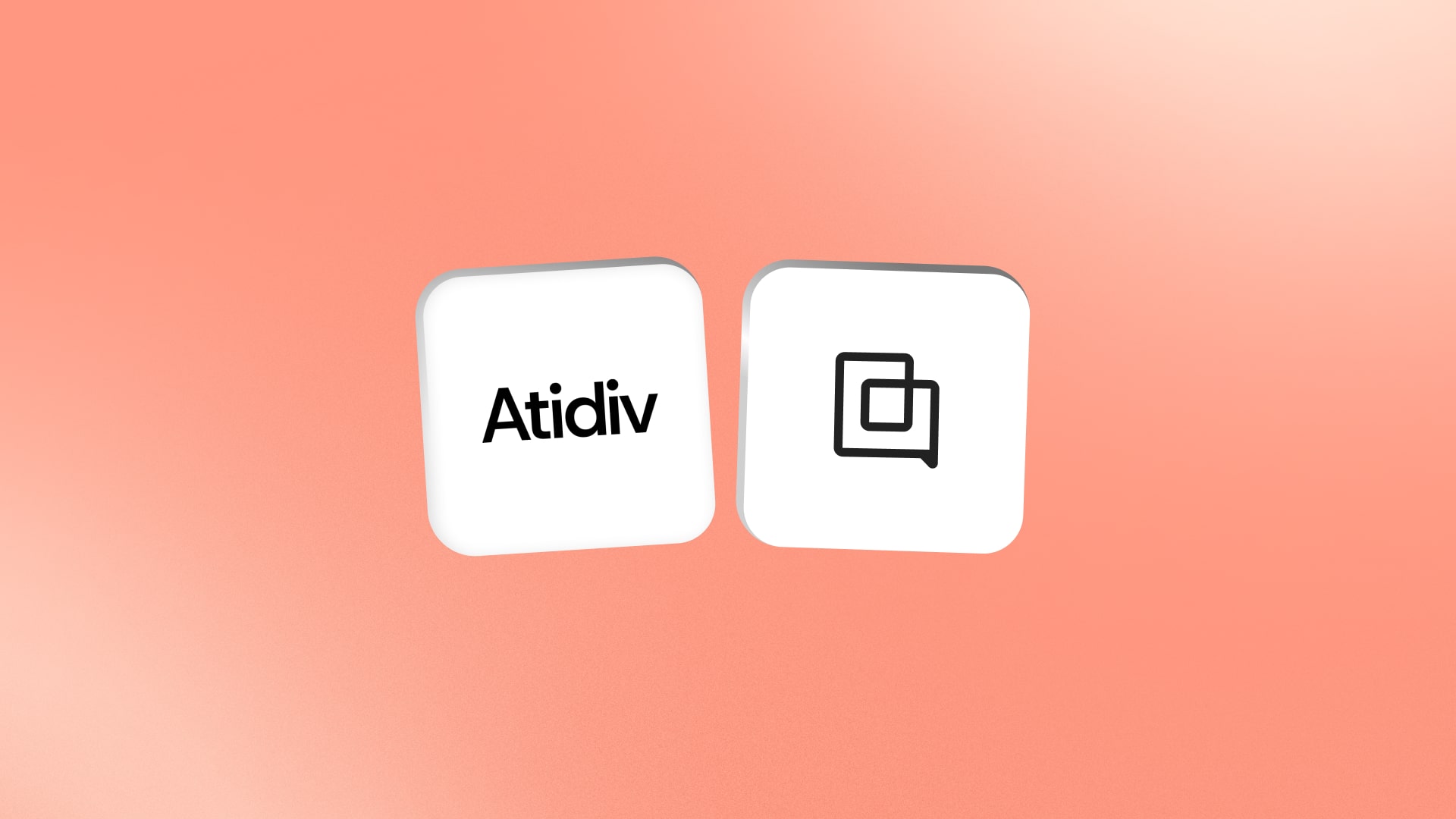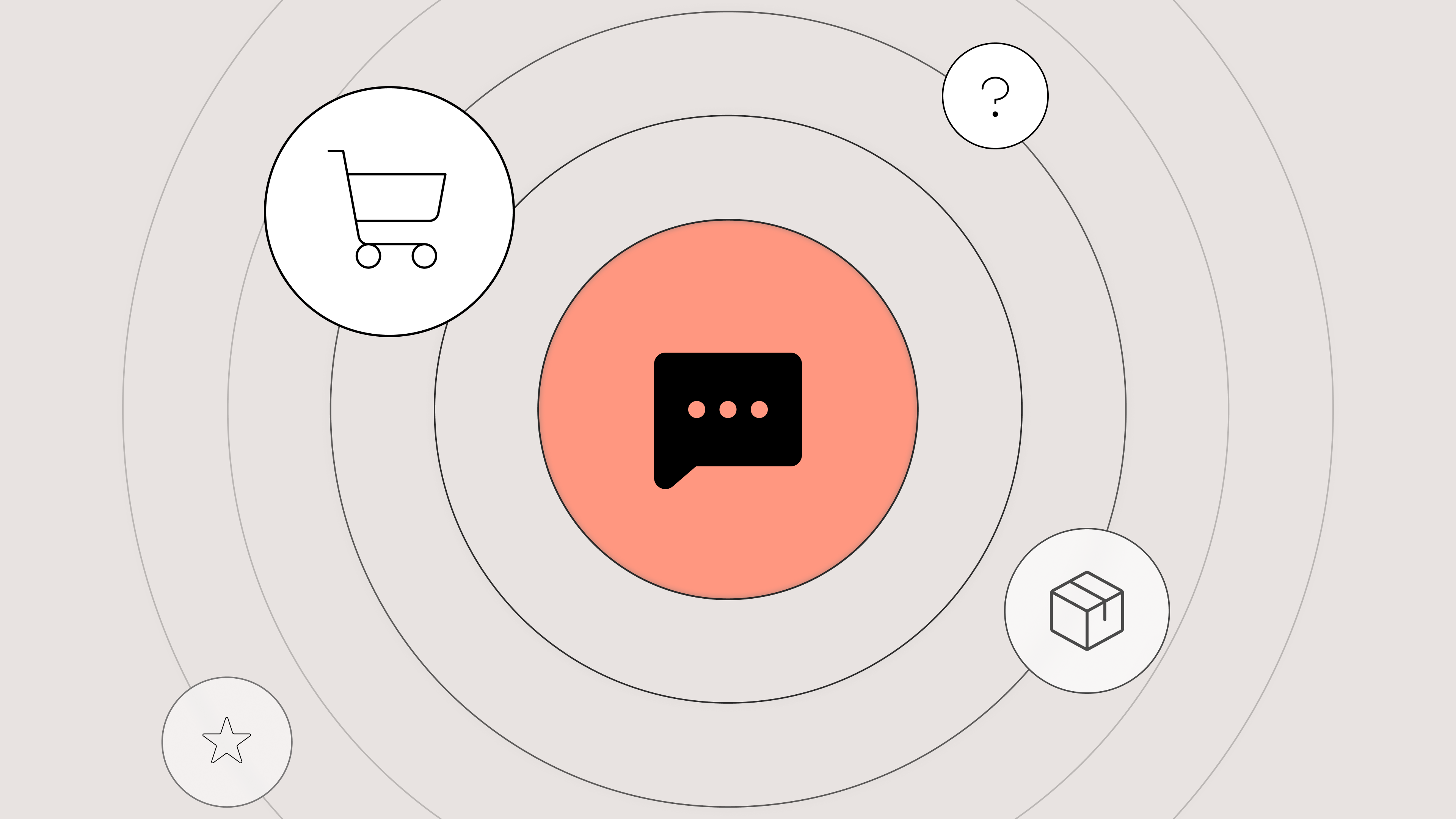

Should You Offer Live Chat Support? A Guide for CX Teams
TL;DR:
- Live chat is the fastest way to help shoppers. It gives customers real-time answers and prevents drop-off.
- You don’t need a 24/7 team to run live chat. Automate FAQs and set clear hours to keep it manageable.
- Live chat improves conversions and customer loyalty. Shoppers who chat are more likely to make a purchase and return to your store.
- Start by automating questions like order tracking and returns. These are easy to answer and make up most of your volume.
- Gorgias makes it easy to launch and scale live chat. You can integrate with your store and go live in under a day.
According to 2025 Gorgias data, chat inquiries are resolved in 24 minutes versus two days on email. It’s no wonder customers prefer live chat over any other support channel.
If you aren’t already offering live chat, it might feel like a big commitment. But when the end product is happier customers, it’s high time to catch up.
Thinking about offering live chat? Learn more about the benefits of live chat customer support, how it differs from chatbots, when and how to use it, and the best live chat tools to use based on your team’s needs.
What is live chat support?
Live chat support is a form of customer service that uses a chat widget to intake customer inquiries. Ecommerce websites, browser-based tools, and mobile apps typically offer live chat in combination with other customer service channels like email, phone, and social media.
Depending on the business, live chat support availability can vary. Some businesses choose to run live chat within their operating hours, while others extend 24/7 availability with the help of automation, conversational AI, or a dedicated off-hours team.
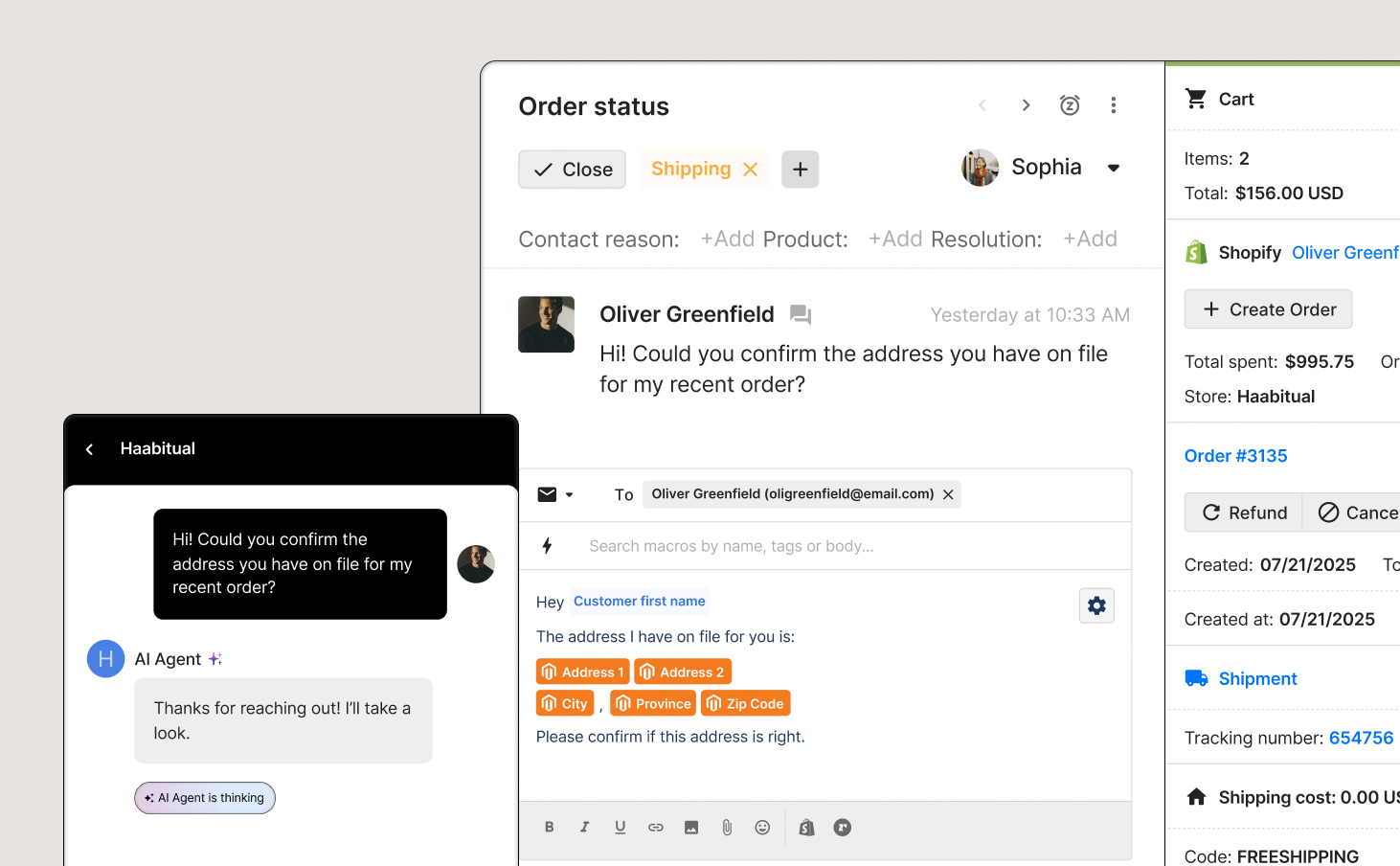
Related: Customer service messaging: Tips and templates for SMS + conversational channels
How does live chat support differ from a chatbot?
The main difference between live chat and chatbots is the option to speak to a live human agent.
With live chat support, customers always have the option of speaking to a live human agent. Meanwhile, chatbots can only provide customers with automated responses, whether preconfigured or generated by AI.
Why should you offer live chat support?
Live chat doesn’t just make support faster—it helps you close more sales.
Aside from quick answers, customers want confidence to buy. In fact, Hiver reports that 63% of consumers prefer live chat over phone and social media, mainly because they get instant answers while they’re still browsing.
Here are the benefits of implementing live chat for your business:
- Customer satisfaction: Customers get the clarity they need while shopping
- Higher conversions: Live chat removes friction at checkout by resolving doubts in real time
- Faster resolutions: Support teams close tickets faster by solving issues right away
- Revenue retention: Agents can recommend the right product, reducing the chance of returns later
Read more: A guide to resolution time: How to measure and lower it
When does live chat make the biggest impact?
Live chat shines in situations where timing directly impacts whether a customer buys your product or walks away. These conversations often happen before a purchase, like when a shopper is deciding between products, has concerns about shipping, or wants to confirm your return policy.
Use live chat in these moments:
|
Moment |
Why Live Chat Works |
|---|---|
|
Before a purchase |
Provides instant product education, assurance, and curbs hesitation due to a lack of information |
|
Order-related concern |
Resolves time-sensitive questions on shipping or changes before the customer bounces |
|
Checkout hesitation |
Reduces cart abandonment by addressing doubts |
|
FAQs |
Deflects repetitive tickets through automation, freeing agents for complex conversations |
|
High-value customers |
Offers high-touch service that reinforces loyalty and drives repeat purchases |
|
Bulk orders |
Accelerates large sales by delivering clarity when urgency is high |
How automation makes live chat support scalable
You don’t need a large support team to offer high-quality live chat support. Sure, live chat can feel risky if you’re a brand with a lean CX team or high ticket volume, but when you automate the right types of conversations, it becomes one of the most impactful support channels.
What to automate first
Start with high-frequency, low-complexity inquiries. These are repetitive questions that don’t require an agent to resolve:
- Order tracking (where is my order)
- Shipping, return, exchange, and cancellation policies
- Basic troubleshooting
- Product education, like sizing or fit guides
These types of tickets typically make up the bulk of your live chat volume. Automating them clears the way for agents to focus on conversations that require more specialized knowledge and nuance.
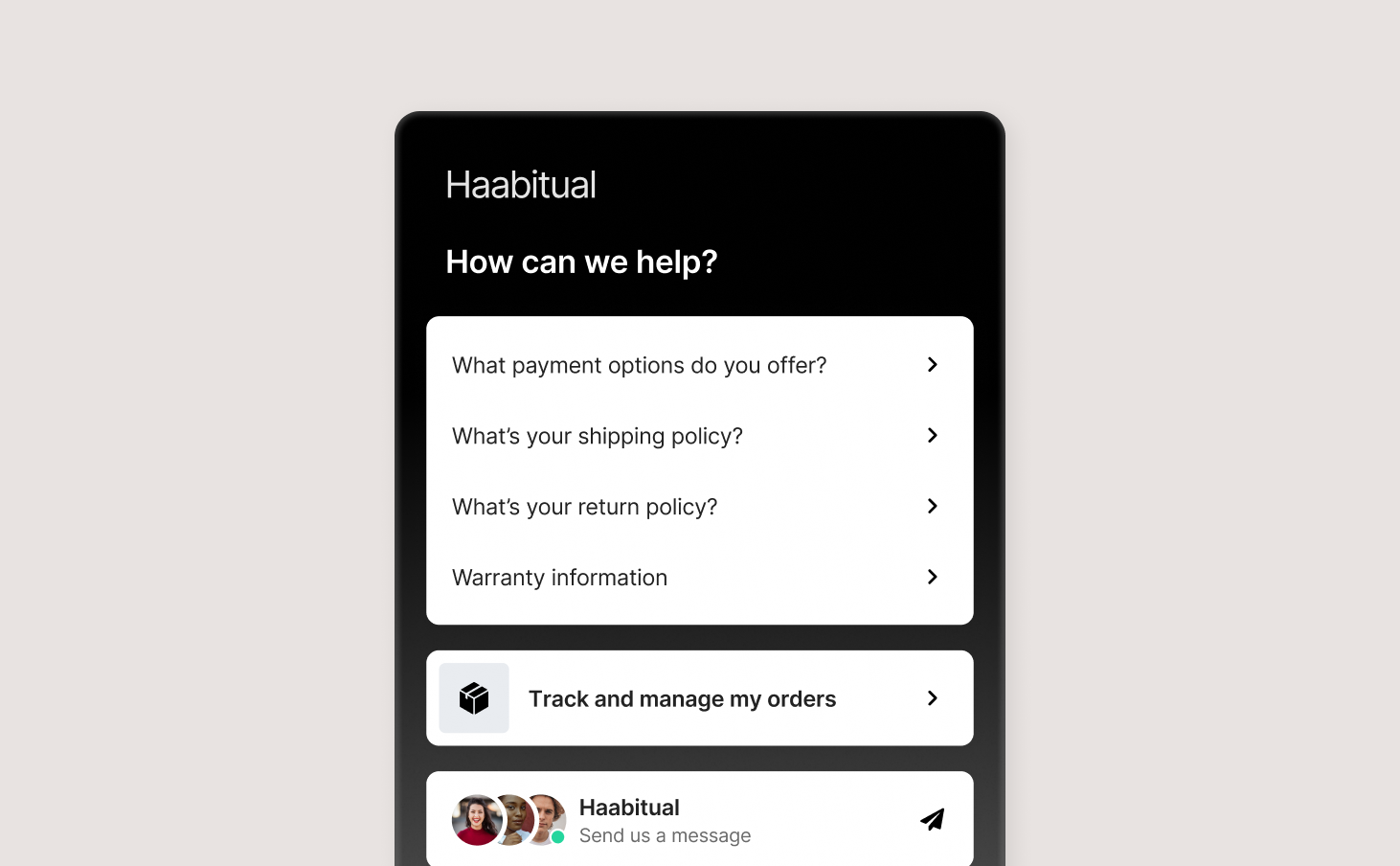
Automation features that help you scale
The best live chat isn’t only a messaging tool, it also comes with features that make the support agents using it more productive.
Here are the top automation features to improve live chat:
- Macros: One-click prewritten replies to common questions that agents can send manually or automatically.
- Customer and product variables: Dynamic details—like name, order number, and delivery date—pulled from your ecommerce platform and inserted into messages can easily make interactions more personalized.
- Flows: Interactive Q&A scenarios that automatically answer customer questions in the chat widget.
- Routing: Prioritize or assign tickets to agents based on topic, urgency, or language for maximum efficiency.
- Conversational AI: Leave live chat on 24/7 with tools like Gorgias AI Agent to answer repetitive questions and update orders—even when your team is offline.
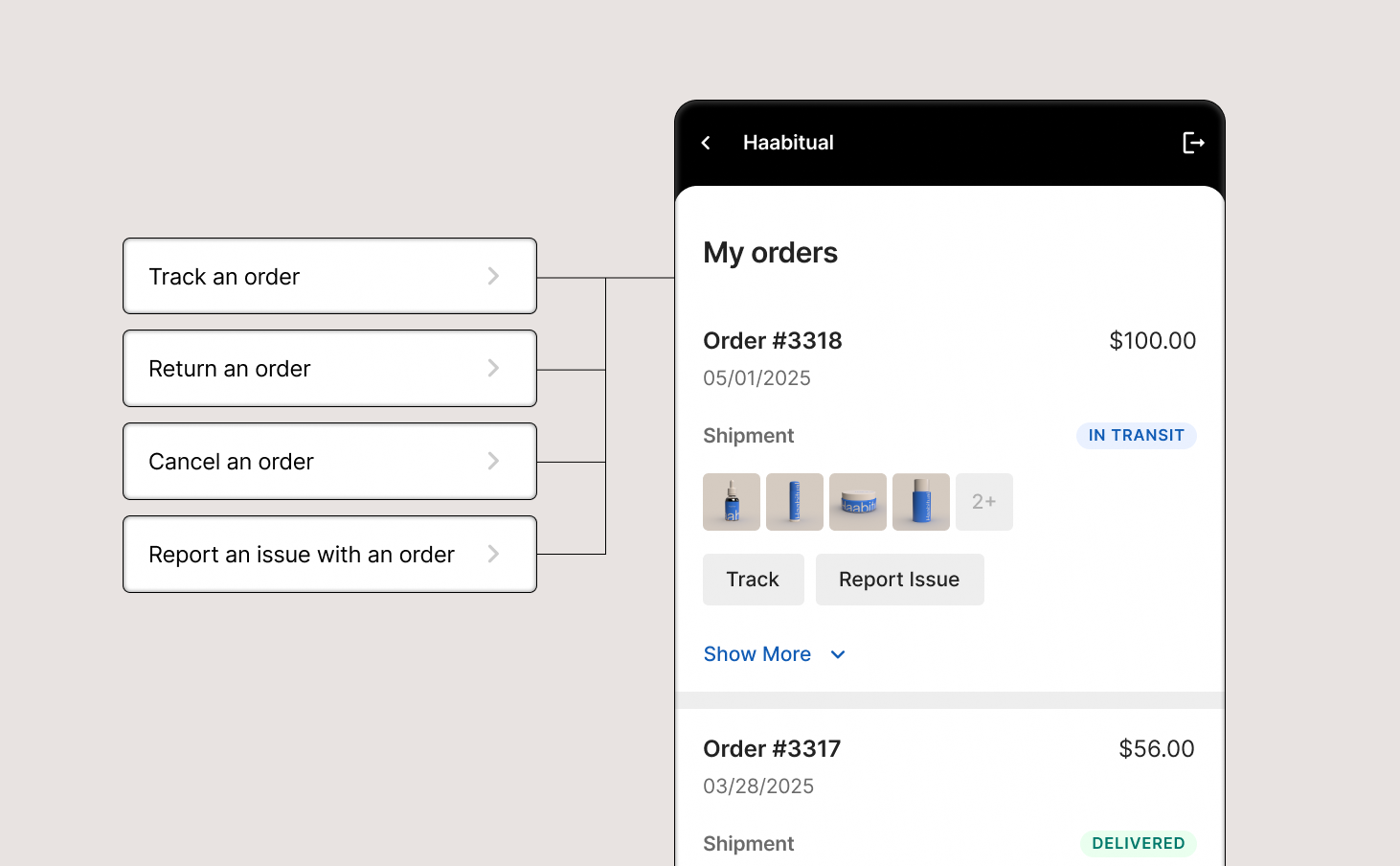
The dos and don’ts of replying to a live chat message
Good live chat messages are quick, helpful, and easy to follow. Poor live chat messages are slow, robotic, or long-winded.
Follow these guidelines to help keep your replies effective and consistent:
|
Do ✅ |
Don’t ❌ |
|---|---|
|
Respond within your target SLA |
Leave customers waiting |
|
Keep responses concise |
Send long, wordy messages |
|
Use macros and templates as a starting point |
Manually type everything again and again |
|
Ask clarifying questions |
Assume you understand everything |
|
Be transparent if you need more time |
Promise something you can’t deliver |
|
Confirm resolution before ending the conversation |
End the chat without checking if the issue is solved |
How to set up live chat without overwhelming your team
Adding live chat for the first time or want to make your current setup more manageable? Start with these five steps:
1. Set live chat hours
You don’t need to be online at all times to offer live chat. Start by choosing live chat hours that reflect your team’s availability and peak shopping hours.
Remember to display your availability on your website clearly to manage customer expectations.
2. Prioritize live chat tickets in your inbox
Customers who reach out to you via chat are active on your site and often close to purchasing.
Create rules in your helpdesk that flag live chat conversations as urgent, so they don’t get buried under slower channels like email. If you have a dedicated agent who handles chat, route all chat tickets to them for instant visibility.
3. Automate your first reply
Set up an auto-response that triggers immediately when someone starts a chat. Even a short message like “Hey! Thanks for your message, an agent will be right with you,” can reduce drop-off and give your team time to prep.
4. Edit your macros for live chat
Templates that work in email may be too wordy in chat. Shorten your macros, simplify the tone, and make sure each response fits cleanly into a chat window. Use dynamic variables to pull in details like order number or shipping status without slowing down your agents.
5. Capture customer emails when live chat is offline
Customers don't stop having problems when your team clocks out. When someone tries to chat outside business hours, collect their email so an agent can follow up once your support team is back online.
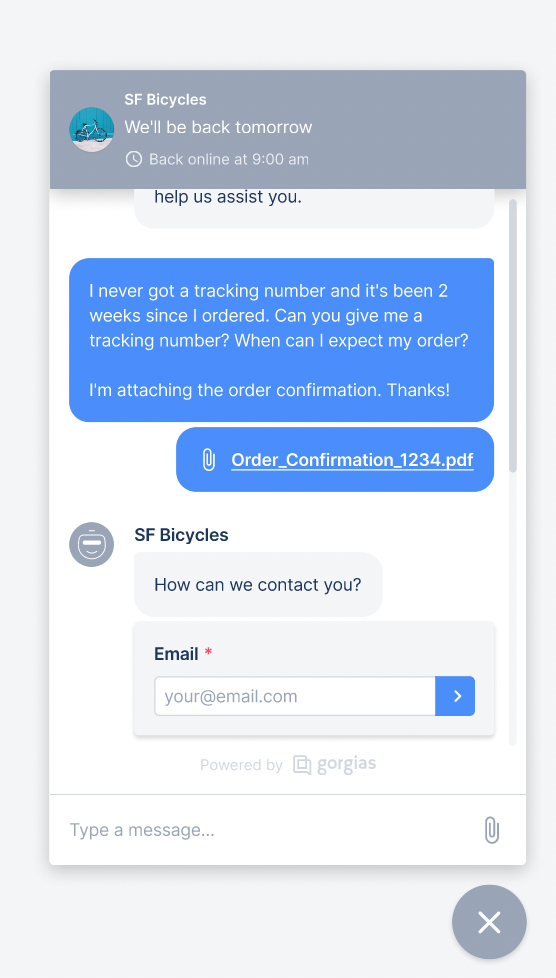
Best live chat tools for CX and support teams
If you’re evaluating live chat software, here are five solid options to start with. Each one fits different team sizes and priorities.
|
Tool |
Pricing Model |
Best For |
Standout Feature |
Limitation |
|---|---|---|---|---|
|
Gorgias |
Per ticket |
Ecommerce brands |
Conversational AI that handles support and drives sales with upsells, recommendations, and context-aware discounts |
Limited AI features for non-Shopify ecommerce stores |
|
Zendesk |
Per user |
Large CX teams with dev resources |
Highly customizable for large support orgs |
Built for general use, not ecommerce; limited email AI; high setup cost |
|
Intercom |
Per user |
SaaS and product companies |
Built-in onboarding and product messaging tools |
Not ecommerce-focused; limited integrations and high AI cost |
|
Tidio |
Per ticket |
SMBs looking for budget automation |
Affordable chatbot + live chat combo |
Lacks visual upsell tools and struggles with complex sales questions |
|
Richpanel |
Per user |
Early-stage teams |
Simple UI and fast time to launch |
Buggy UI, no AI Agent, slow updates, poor Shopify automation |
Deliver faster support without adding headcount
Gorgias helps ecommerce brands deliver fast support without cutting into your budget. Automate common questions with conversational AI, resolve tickets in seconds, support and sell, and give your team the context they need to handle complex conversations with one tool.
Want live chat that takes support to the next level? Book a demo.
{{lead-magnet-2}}
TL;DR:
- Train your AI like a new hire. Give it tone guidelines, review weekly, and keep refining to stay on-brand.
- Adapt AI to real customer behavior. Adjust tone and timing to improve satisfaction, even if the answer stays the same.
- Use AI to drive sales, not just support. Top brands use it to answer product questions and guide pre-purchase decisions.
- Start small and improve as you go. Begin with one common question and test often to build momentum.
If you’ve been side-eyeing AI and wondering if it’s just hype, you’re not alone. A lot of CX leaders were skeptical, too:
“I used to be the loudest skeptic,” said Amber van den Berg, Head of CX at Wildride. “I was worried it would feel cold and robotic, completely disconnected from the warm, personal vibe we’d worked so hard to build.”
But fast forward to today, and teams at Wildride, OLIPOP, bareMinerals, and Love Wellness are using AI to do more than just deflect tickets. They’re…
- Cutting costs without cutting corners
- Driving revenue before a customer even checks out
- Delivering fast, on-brand, human-feeling support at scale
Here are six lessons you can steal from the brands doing it best.
{{lead-magnet-1}}
1. Think of AI as your sidekick
We need to get one point across clearly: AI isn’t about replacing your support team.
For brands with lean CX teams, burnout is a serious problem. And it’s one of the biggest reasons AI adoption is accelerating.
“I was constantly seeing the same frustrating inquiries—sponsorship asks, bachelorette party freebies, PR requests… 45% of our tickets were these kinds of messages,” said Nancy Sayo, Director of Consumer Services at global beauty brand, bareMinerals.
“Once I realized AI could handle them with kindness and consistency without pulling in my team, I was sold.”
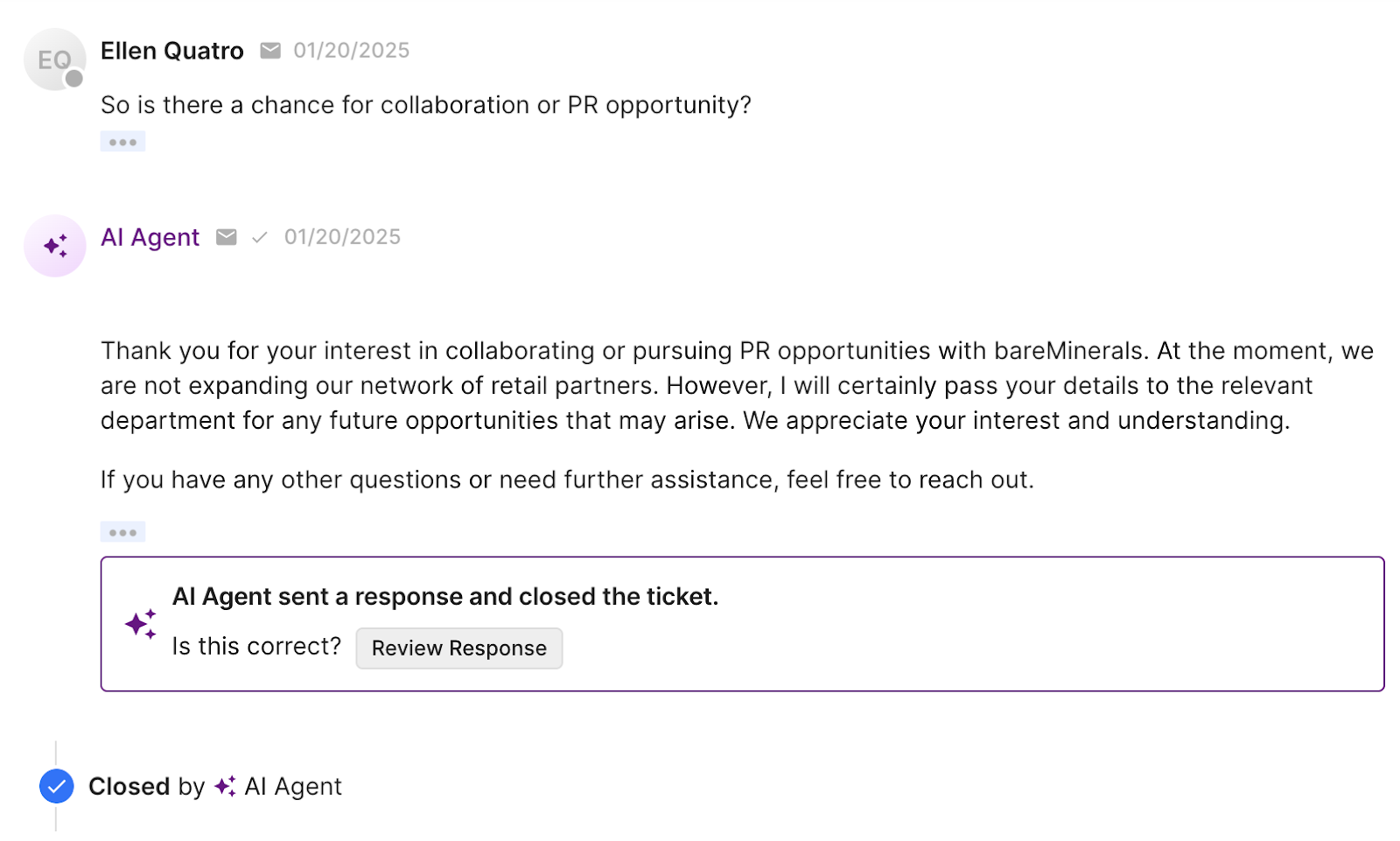
Instead of thinking of AI as a replacement, think of it as an enhancement.
It’s about making sure your CX team doesn’t burn out answering the same five questions 50 times a day.
With Gorgias AI Agent, Nancy’s team now uses automation to absorb the high-volume, low-conversion noise, freeing up their seasoned agents to focus on real revenue-driving moments.
“We use AI to handle low-complexity tickets. And we route higher-value customers to our human sales team—people who’ve been doing makeup for over a decade and really know what they’re doing.”
TL;DR? The smartest teams use AI to take the weight of repetitive tickets (“Do you ship internationally?” “Can I get free samples?”) off their shoulders so agents can focus on conversations that build trust, drive loyalty, and increase LTV.
2. Train your AI like a team member
While you can get started with AI quickly for simple queries, we don't recommend using it “out of the box.” And honestly, that’s a good thing.
Brands that “set it and forget it” are missing the point. Because if you want AI to sound exactly like your brand—not like every other chatbot on the internet—you need to give it the same context you’d give a new hire.
Amber van den Berg, Head of Customer Experience at baby carrier brand Wildride, wrote out detailed tone guidelines, including:
- Dos and don’ts for customer conversations
- Approved Dutch-to-English translations
- Example replies for nuanced, emotional questions
- Pre-written macros for product recs and delivery issues

“Lisa, our AI agent, is basically a super well-trained intern who never sleeps. I give her the same updates I give my human team, and I review Lisa’s conversations every week,” said Amber. “If something feels off-brand, too robotic, or just not Wildride enough, I tweak it.”
The feedback never stops, and that’s what makes Lisa so effective.
Related: Meet Auto QA: Quality checks are here to stay
3. Let AI mirror the pacing of real conversations
Even when AI gets it right, customers might not always feel like it did. Especially if the tone of voice is off or if your customer base just isn’t used to automation.
“Our CSAT was low at first,” said Nancy Sayo of bareMinerals. “Even if the response was accurate and beautifully written, our older customers just didn’t want to interact with AI.”
So Nancy’s team adapted. Rather than giving customers a blunt “no” to product requests, they restructured the flow:
“If someone asked for free product, we’d say, ‘We’ll send this to the team and follow up.’ Then, 3-5 days later, the AI would close the loop. It softened the blow and made customers feel heard—even if the answer didn’t change.”
That simple tweak raised CSAT and created a better customer experience without requiring a human to step in.
Inside Gorgias, teams like bareMinerals review AI performance weekly, not just to catch mistakes, but to optimize for tone, satisfaction, and brand feel. They use:
- CSAT reporting to spot dips in sentiment
- Conversation analytics to flag where AI may be losing trust
- Macro editing to quickly adjust common replies
AI gives you the flexibility to test, tweak, and tailor your approach in a way traditional support channels never could.

4. Use AI to drive sales—not just support
Too many CX teams still treat AI like a glorified autoresponder. But the most forward-thinking brands are using it to guide shoppers to checkout.
“Our customers often ask: ‘Which carrier is better for warm weather?’ or ‘Will this fit both me and my taller partner?’” said Amber van den Berg, Head of CX at Wildride. “Lisa doesn’t just answer—she gives context, recommends features, and highlights small touches like the fact that a diaper fits in the side pocket.”
With Gorgias Shopping Assistant, brands can turn AI into a proactive sales assistant—answering product questions in real time, referencing what’s in the customer’s cart, and nudging them toward the best option with empathy.
5. CX insights should power the rest of your business
Great support doesn’t stop at the inbox. At Love Wellness, CX is the connective tissue between ecommerce, product, and marketing.
“We meet quarterly with our CX and ecommerce teams to review top questions, objections, and patterns,” said Mckay Elliot, Director of Amazon at Love Wellness. “That feedback goes straight into product development and PDP optimizations on both DTC and Amazon.”
But it’s not just a quarterly ritual. Feedback sharing is embedded in the culture, and they do this with a Slack channel dedicated to customer feedback.
Dropping in insights is part of the team’s daily and weekly responsibilities. It helps everyone stay close to the content, and it sparks real collaboration on what we can improve. They then use those insights to improve ad messaging and content.
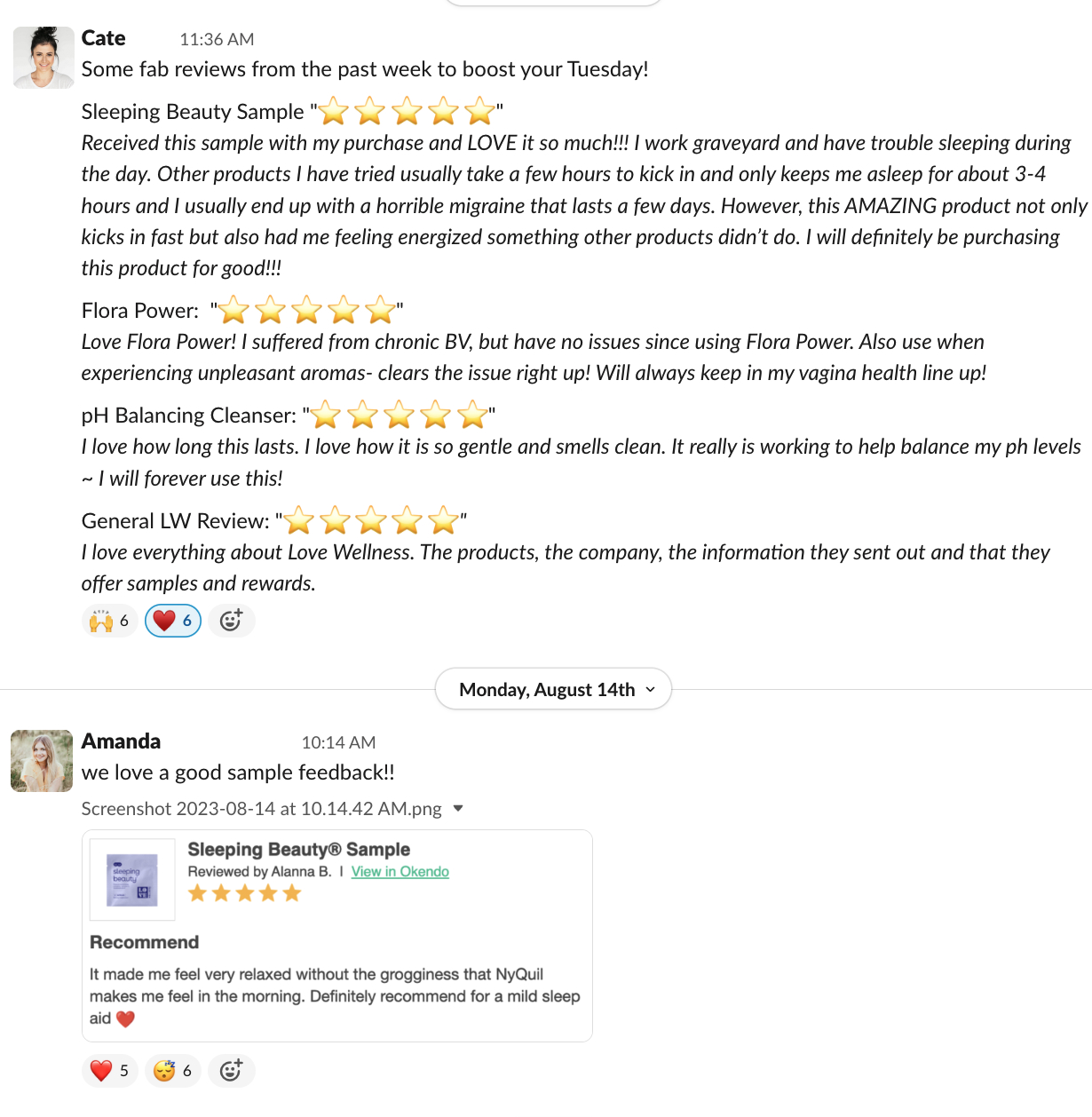
Your team has so much data they can review between channels like email, SMS, chat, and social media—both compliments and complaints. You need to be willing to listen to every customer’s needs.
Read more: Why customer service is important (according to a VP of CX)
6. Don’t overthink it, start small
One of the biggest mistakes brands make with AI? Trying to do too much, too soon.
Rolling out AI should feel like a phased launch, not a switch flip. The best results come from starting simple, testing often, and iterating as you go.
“We started with one simple question—‘Do you ship internationally?’—and built from there,” said Amber van den Berg of Wildride.
“And if it doesn’t work? You can always turn it off,” added Anne Dyer, Sr. Manager of CX & Loyalty Marketing at OLIPOP. “The key is to test, review, and keep iterating. AI should enhance your human experience, not replace it.”
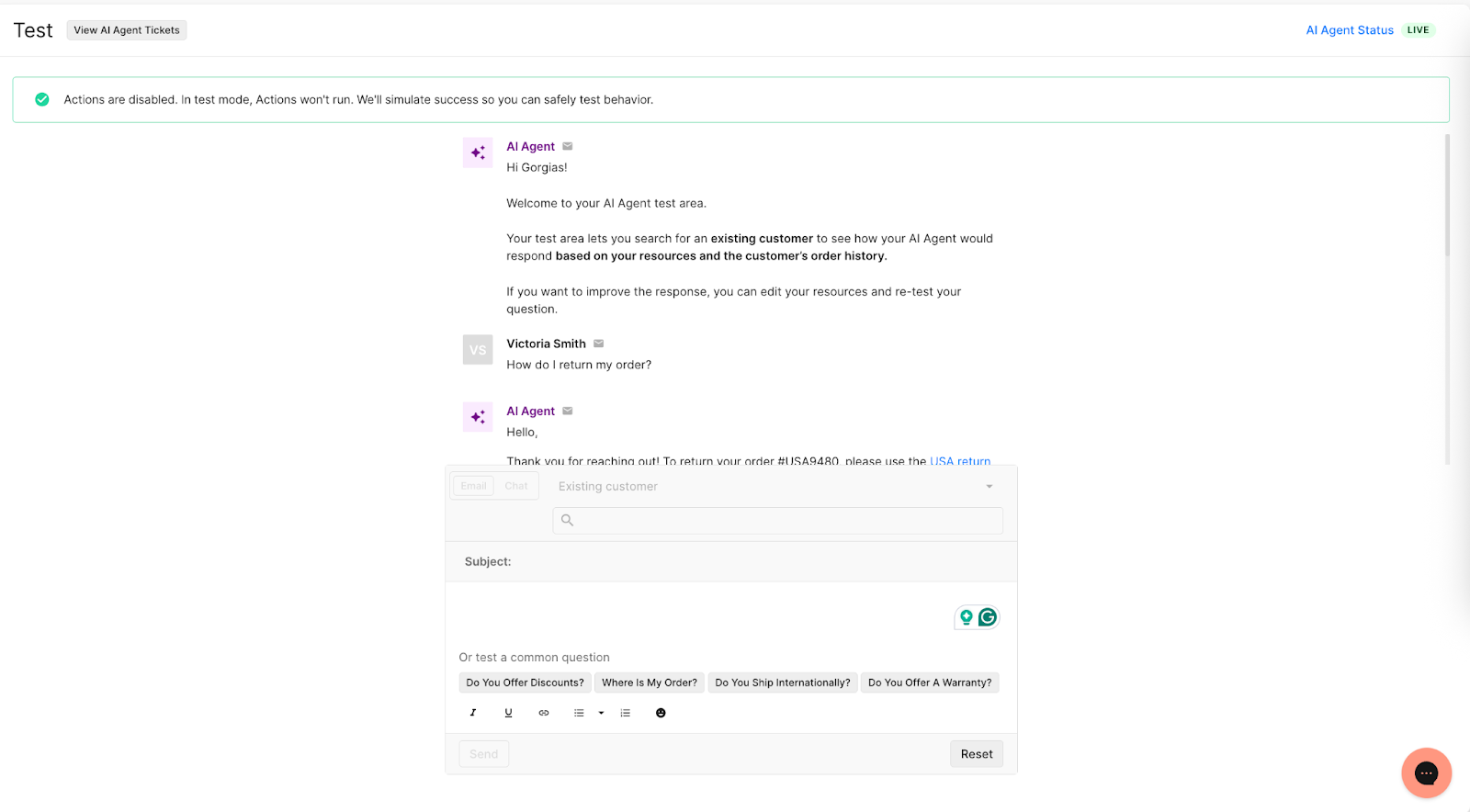
If your helpdesk supports it, start in a test environment to preview answers before going live. Then roll out automation gradually by channel, topic, or ticket type and QA every step of the way.
For most brands, the best starting point is high-volume, low-complexity tickets like:
- “Where’s my order?”
- Subscription pauses or cancellations
- Returns and exchanges
- Store policies and FAQs
You don’t need to solve everything on day 1. Just commit to one question, one channel, and one hour per week. That’s where real momentum starts.
Related: Store policies by industry, explained: What to include for every vertical
How do you measure the impact of AI in CX?
Most CX teams are used to tracking classic metrics like ticket volume and CSAT. But when AI enters the mix, your definition of success shifts. It’s not all about how fast you handle tickets anymore—it’s about how customers feel after conversations with AI, team efficiency, and the quality of every interaction.
Here are the metric CX teams used to track without AI—and what they track now with AI:
|
Metrics Tracked Before AI |
Metrics Tracked After AI |
|---|---|
|
Total ticket volume |
% of tickets resolved by AI |
|
Average first response time |
Response time by channel (AI vs. human) |
|
CSAT (overall) |
CSAT + sentiment on AI-resolved tickets |
|
Tickets per agent/hour |
Time saved per agent + resolution quality |
|
Burnout rate or turnover |
Agent satisfaction or eNPS |
The best use of AI makes space for human touch
AI isn’t here to replace your CX team. It’s here to free them up, so they can focus on deeper, more meaningful conversations that build loyalty and drive revenue.
So if you’re on the fence, start small. Train it. Review weekly. Build the muscle.
You’ll be surprised how quickly AI becomes your favorite intern.
If you want more tips from the experts featured today, you can:
Newsletter Signup
The best in CX and ecommerce, right to your inbox
Featured articles
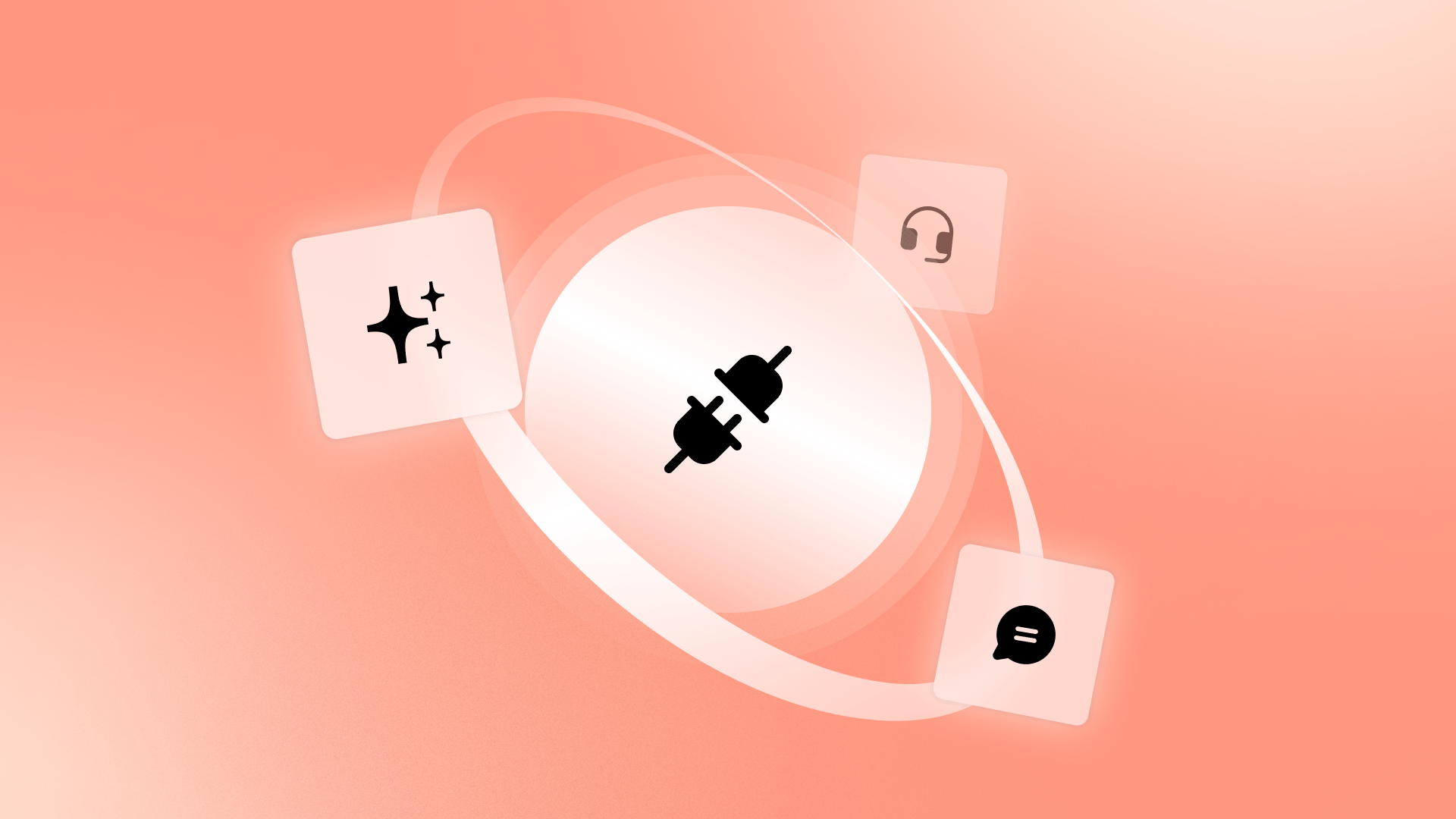
Why Consolidated Doesn’t Mean Compromised: Top 3 Myths Debunked
TL;DR:
- Consolidation doesn’t mean giving up flexibility. The right all-in-one tools are modular and API-friendly, so teams can customize and integrate freely.
- You gain efficiency, not lose features. One platform means fewer gaps, less manual work, and faster support.
- It’s more affordable and faster than you think. Consolidation cuts hidden costs and delivers ROI quickly.
- Gorgias is built for ecommerce. With a deep Shopify integration and 100+ apps to connect to, it can scale with CX teams, no matter their size.
If your CX team is juggling a dozen different tools just to answer one support ticket, you’re not alone. According to our 2025 Ecommerce Trends report, 42.28% of ecommerce professionals use six or more tools every day. Plus, nearly 40% spend $5,000–$50,000 annually on their tech stack.
That’s a lot of money and a lot of tabs.
It’s no wonder “tech stack fatigue” is setting in. But while many brands are ready to simplify, there’s still hesitation around consolidation. The biggest fear is that all-in-one tools are too rigid or basic to handle the complexity of a growing business.
But the truth is, consolidation doesn’t mean compromise. When done right, it means clarity, speed, and control. It also means fewer tools, smoother workflows, and faster customer support.
Let’s bust some myths and show you what smart consolidation looks like.
{{lead-magnet-1}}
Myth #1: “All-in-one tools are too rigid”
One of the biggest blockers to consolidation is compatibility. Fifty-two percent of ecommerce professionals said they hesitate to consolidate because they’re worried about tools not playing nicely together.
That hesitation makes sense. In the past, “all-in-one” tools meant being locked into a single provider’s ecosystem, with limited integrations and rigid workflows. For CX teams managing fast-moving ops and dozens of tools, from email and returns to reviews and subscriptions, the idea of losing flexibility is a non-starter.
Reality: All-in-one tools are modular, not monolithic
Modern support platforms have moved away from monolithic systems and toward modular API-friendly designs that give brands control instead of constraints.
If you choose the right platform, consolidation doesn’t lead to a loss of functionality. Instead, it means getting a better-connected system that works smarter.
Just ask Audien Hearing who uses Gorgias’s open API to create an integration with its warehouse software to manage returns directly in Gorgias instead of a shared Google spreadsheet.
They also combine the power of Gorgias Voice with an integration to Aircall to resolve thousands of questions a day. This integration enables agents to access customer and order data directly from Gorgias while on a call—staying in one workspace.
“It's amazing that we're able to create any custom solutions we want with Gorgias's open API. Gorgias is way more than a typical helpdesk if you utilize the features it offers,” says Zoe Kahn, VP of Retention and Customer Experience at Audien Hearing.
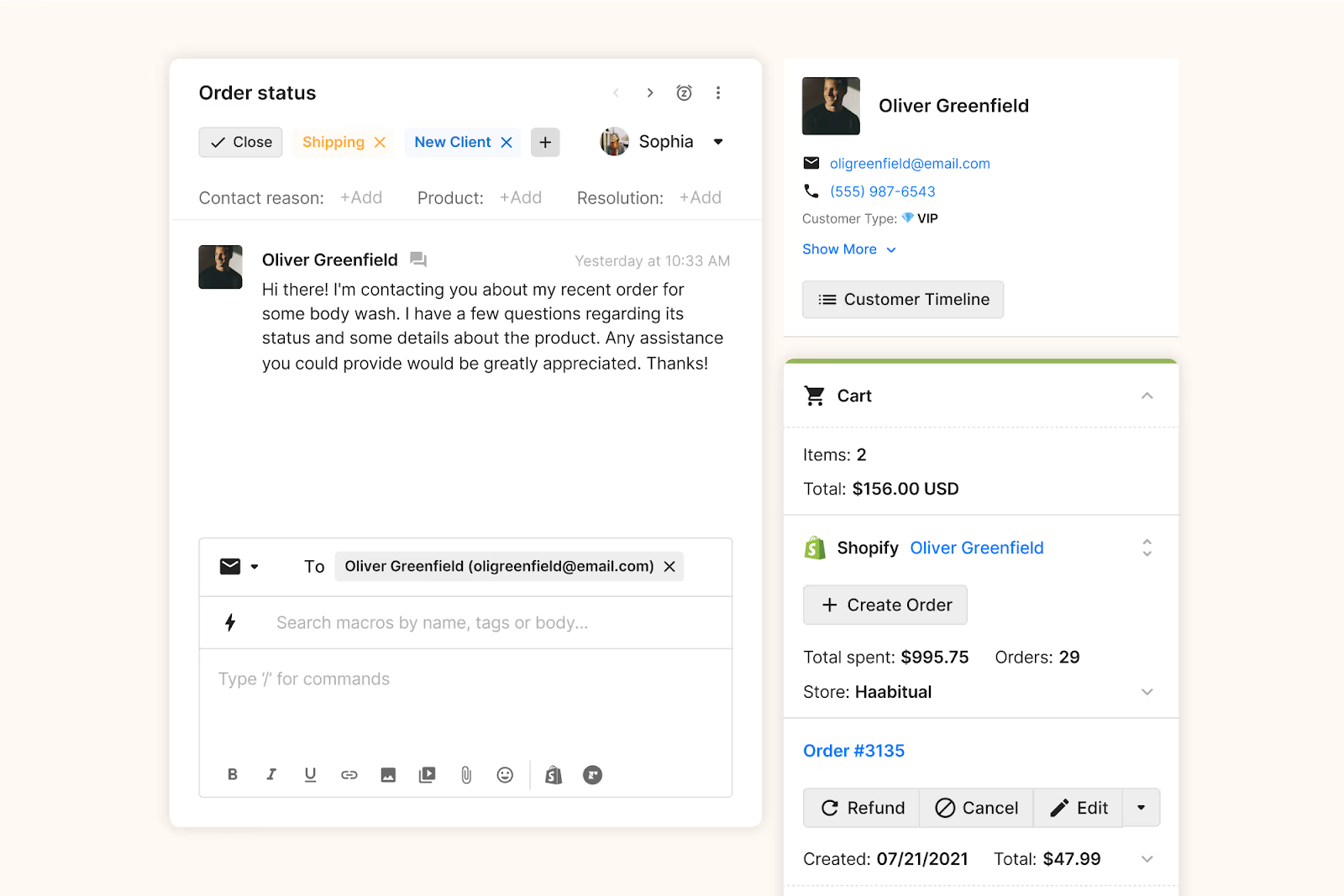
Read more: The Gorgias & Shopify integration: 8 features your support team will love
Myth #2: “We’ll lose features we rely on”
Another common hesitation around consolidation is the risk of putting all your eggs in one basket. If everything runs through one tool, what happens when something breaks or you need to pivot?
It’s understandable, many teams worry that one tool can’t possibly do everything well. Maybe it won’t support their preferred channels, or the automation will be too limited. Or maybe they’ve been burned by a platform that promised too much and delivered too little.
Reality: All-in-one tools reduce gaps, not capabilities
In reality, consolidating gives CX teams more freedom, not less.
Instead of stitching together half a dozen tools and hoping they sync, teams using a single, well-integrated platform gain:
- A centralized view of the customer
- Cleaner workflows with fewer manual handoffs
- Less time spent training agents on multiple systems
- And fewer gaps in data or context
Under one system, your team doesn’t have to jump between tabs anymore. They can just focus on helping customers, quickly and consistently.
Take it from Osea Malibu, a seaweed‑infused skincare brand that transformed their support quality assurance process using Gorgias Auto QA. Their manual QA system was time-consuming and couldn’t scale as ticket volume surged. But the switch made impressive improvements:
- QA time reduced by 75%, from over an hour per week to just 15 minutes
- 100% of tickets now automatically quality‑checked, instead of a small manual sample
- CSAT increased (during BFCM) to 4.74/5, reflecting better consistency and faster resolutions

“Gorgias Auto QA saved me so much time. What used to take over an hour now only takes 15 minutes a week, and I no longer have to worry about spreadsheets.” —Sare Sahagun, Customer Care Manager at Osea Malibu
Myth #3: “Consolidation is expensive and time-consuming”
On paper, consolidation sounds smart. But 47.6% of ecommerce professionals say cost is a barrier, and 40.3% worry about the time it takes to implement a new system.
Sticking with a fragmented stack isn’t exactly cheap or quick, either. Between training new agents, managing multiple vendors, and patching together tools that don’t fully sync, the hidden costs add up fast.
Reality: Consolidation reduces overhead and busywork
It’s not actually consolidation that drains your resources—it’s complexity. And with Gorgias, simplifying pays off fast.
Trove Brands is a standout example. After centralizing their support with Gorgias, they implemented AI-powered order cancellation workflows and saw:
- 45% of tickets automated, cutting manual workload
- 70% reduction in failed order cancellations, saving costs and frustration
- 99.93% faster first response time during BFCM 2024 (from 11 hours 30 minutes to just 30 seconds)
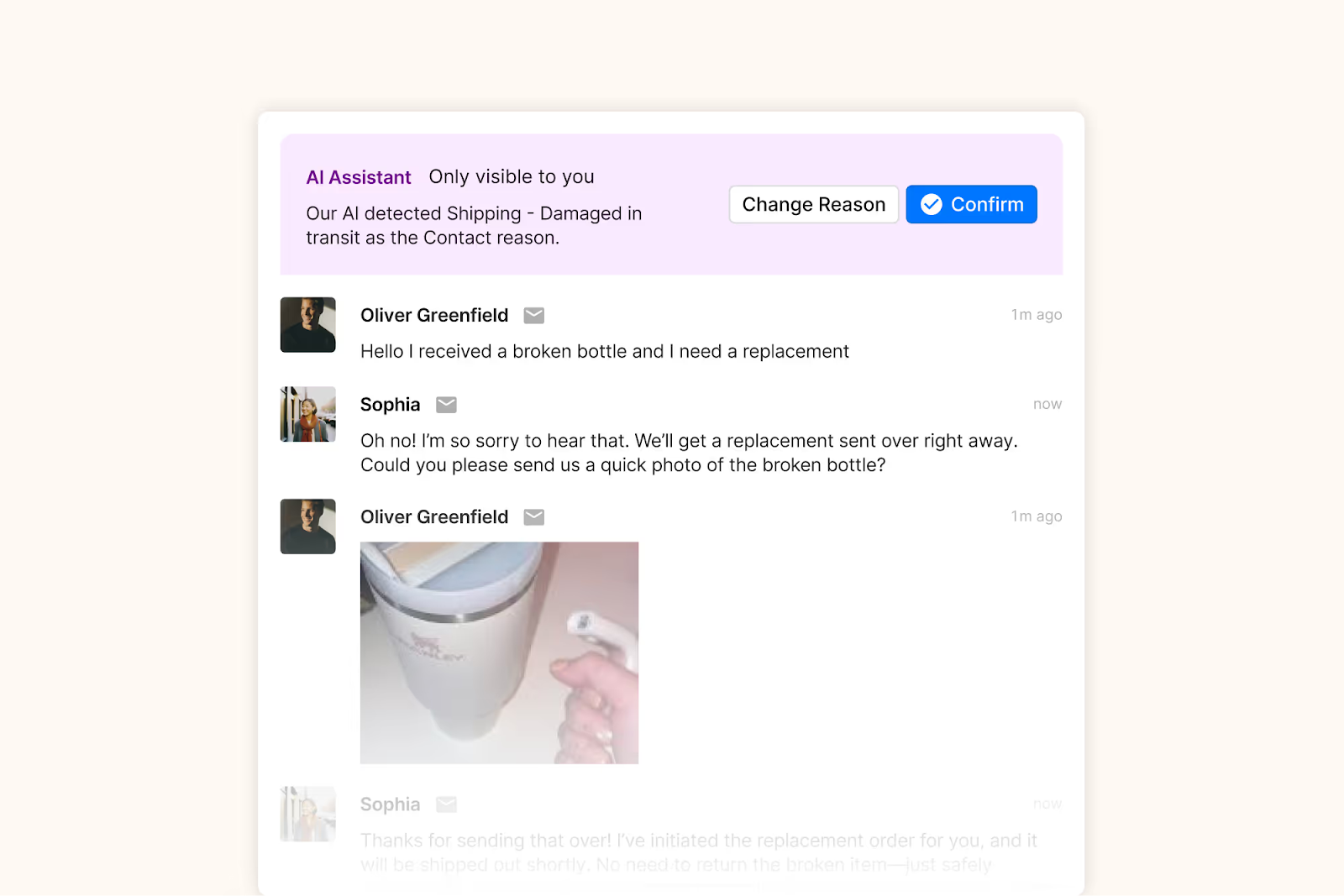
Related: The hidden cost of not adopting AI in ecommerce
What’s the top benefit of consolidating your tech stack?
The biggest benefit of fewer tools is efficiency. It’s also a direct line to real business impact.
Constant tab-switching and duplicate data entry mean way too much time spent managing platforms instead of helping customers.
When you consolidate your tech stack, your team spends less time learning new systems, chasing down info, or waiting for one tool to sync with another.
Instead, they get everything they need in one place, faster replies, smoother workflows, and happier customers.
And that all adds up to better CSAT, lower churn, and a support team that’s finally free to focus on what matters.
What makes Gorgias different from other all-in-one platforms?
Gorgias is built specifically for ecommerce brands, with features that reflect the way CX teams actually work.
As Shopify’s only Premier Partner for customer support, we offer a native integration that pulls in key order data and context automatically, so agents have everything they need without switching platforms. That means conversations, AI, automation, revenue data, and reporting are in one place.
Our open app ecosystem allows you to connect to 100+ tools like Shopify, Klaviyo, Yotpo, and Recharge in just a few clicks. Need more customization? Our add-ons, like AI Agent and Voice let you level up at your own pace.
Whether you're handling hundreds of tickets a week or scaling globally, Gorgias adapts—so you don’t have to keep reinventing your support stack every six months.
Time to rethink your stack
Dr. Bronner’s, a globally recognized organic soap and personal care brand, made the switch from Salesforce to Gorgias to keep up with growing support demands, and it paid off fast.
Here are the results they saw with Gorgias:
- $100,000 saved in the first year by cutting licensing and developer costs
- 45% of all customer queries automated after just 2 months
- 74% reduction in ticket resolution time, powering faster support
- 11% increase in CSAT, thanks to quicker, more personalized responses
“We don’t get boxed out because we only work with Gorgias tools. Gorgias deeply understands the needs of CX, Shopify, and orders and how those tools work together so that it’s really easy for us to work across the board throughout those tools and that didn’t exist in our last setup at all,” says Emily McEnany, Senior CX Manager at Dr. Bronner’s.
If you’re still stitching together half a dozen tools to handle support, it might be time to ask: Is your tech stack helping you or holding you back?
With Gorgias, you get centralization and flexibility, so your team can move faster, serve better, and scale smarter.
Book a demo or dive into the full 2025 Ecommerce Trends report to see how other brands are rethinking their stacks.
{{lead-magnet-2}}
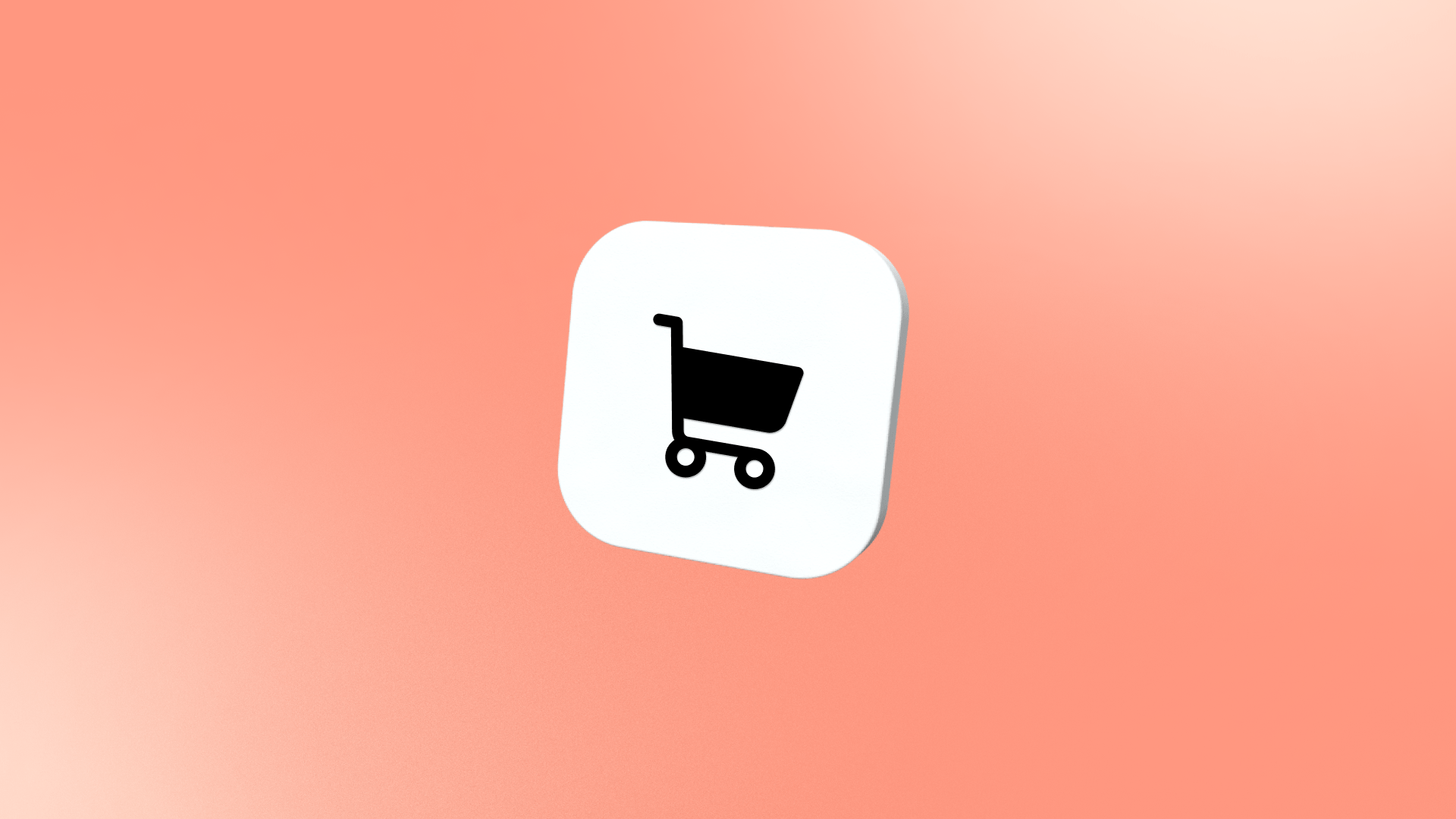
You’re Missing Out on Sales Without an AI Shopping Assistant—Here’s Why
TL;DR:
- Shoppers won’t wait for help—so they leave. Without instant answers, you’re losing sales to hesitation and unanswered questions.
- AI shopping assistants step in right away. They guide, recommend, and resolve concerns in real time, 24/7.
- They boost conversions and AOV. Brands like Pepper and TUSHY saw up to 62% more conversions after adding one.
- They go beyond chatbots. AI assistants proactively sell, using browsing behavior to tailor messages and close more carts.
- Gorgias Shopping Assistant is built for Shopify brands. It starts conversations, mirrors your brand voice, uses browsing data, suggests products, and sends dynamic discounts.
Shoppers aren’t always going to reach out and ask the questions they have, especially if they’re going to have to wait for a response from a CX team.
That means you’re losing sales to friction, indecision, or information gaps.
In 2025, the average cart abandonment rate is 70.19%. But if you can find an AI tool that doubles as a support and sales agent, it could make all the difference.
Gorgias’s Shopping Assistant, for example, has brought a 62% uplift in conversion rate for brands that implement it.
Ahead, learn where you can leverage an AI shopping assistant to increase conversions and craft better purchase experiences.
What is an AI shopping assistant?
An AI shopping assistant is a chat tool powered by AI to provide pre-sales support for shoppers. It can answer questions, make product recommendations, and help guide shoppers in the right direction if they’re stuck.
Gorgias's Shopping Assistant is a powerful, hyper-personalized AI tool built for Shopify brands. Unlike other AI tools, Shopping Assistant starts conversations with customers, not the other way around. It’s uniquely tailored for each customer by tracking browsing behavior during each session and remembering what shoppers say, keeping conversations natural and recommendations relevant.
It’ll also chat with shoppers in your own brand voice, as its responses are pulled right from the knowledge you feed it.
At which point do brands lose sales in the customer journey?
The stages of the customer journey where common drop-off points occur for brands that lack proactive support include:
- Discovery (casual browsing)
- Interested (considering making a purchase)
- Ready to buy (strong purchase intent)
1) Discovery (casual browsing)
There’s a big chance that shoppers—especially first-timers—have questions, but aren’t willing to wait for a human to get back to them. And when your CX team is off the clock? Customers will likely leave altogether.
An AI shopping assistant can help you engage customers right away, even outside your business hours.
Bra brand Pepper uses Gorgias Shopping Assistant to help shoppers find their perfect size. When it detects hesitation, Shopping Assistant points customers to the sizing guide.
This proactive approach creates an easy path for conversation and sets the precedent that any questions will be answered immediately, providing a better––and less confusing––experience.
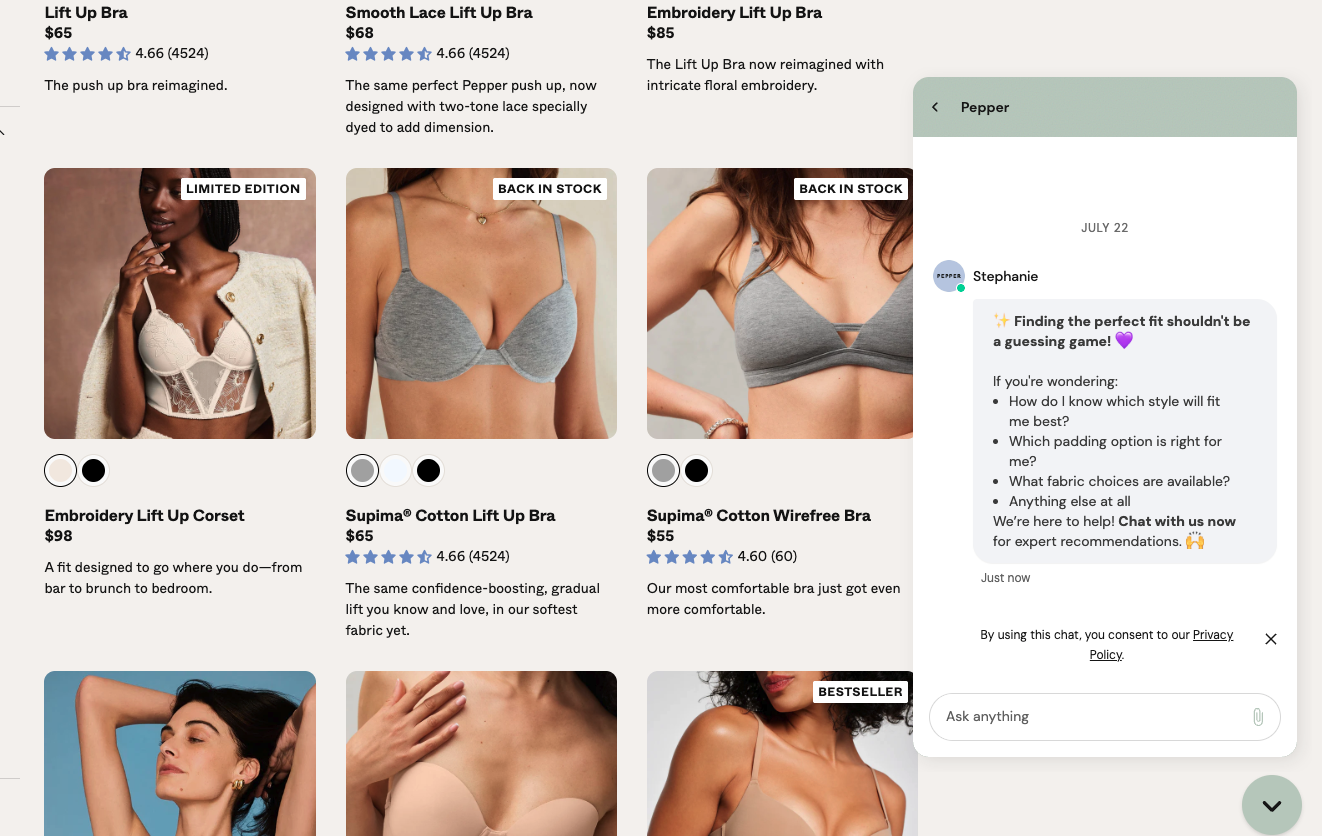
“With Shopping Assistant, we’re not just putting information in our customers’ hands; we’re putting bras in their hands,” says Gabrielle McWhirter, CX Operations Lead at Pepper.
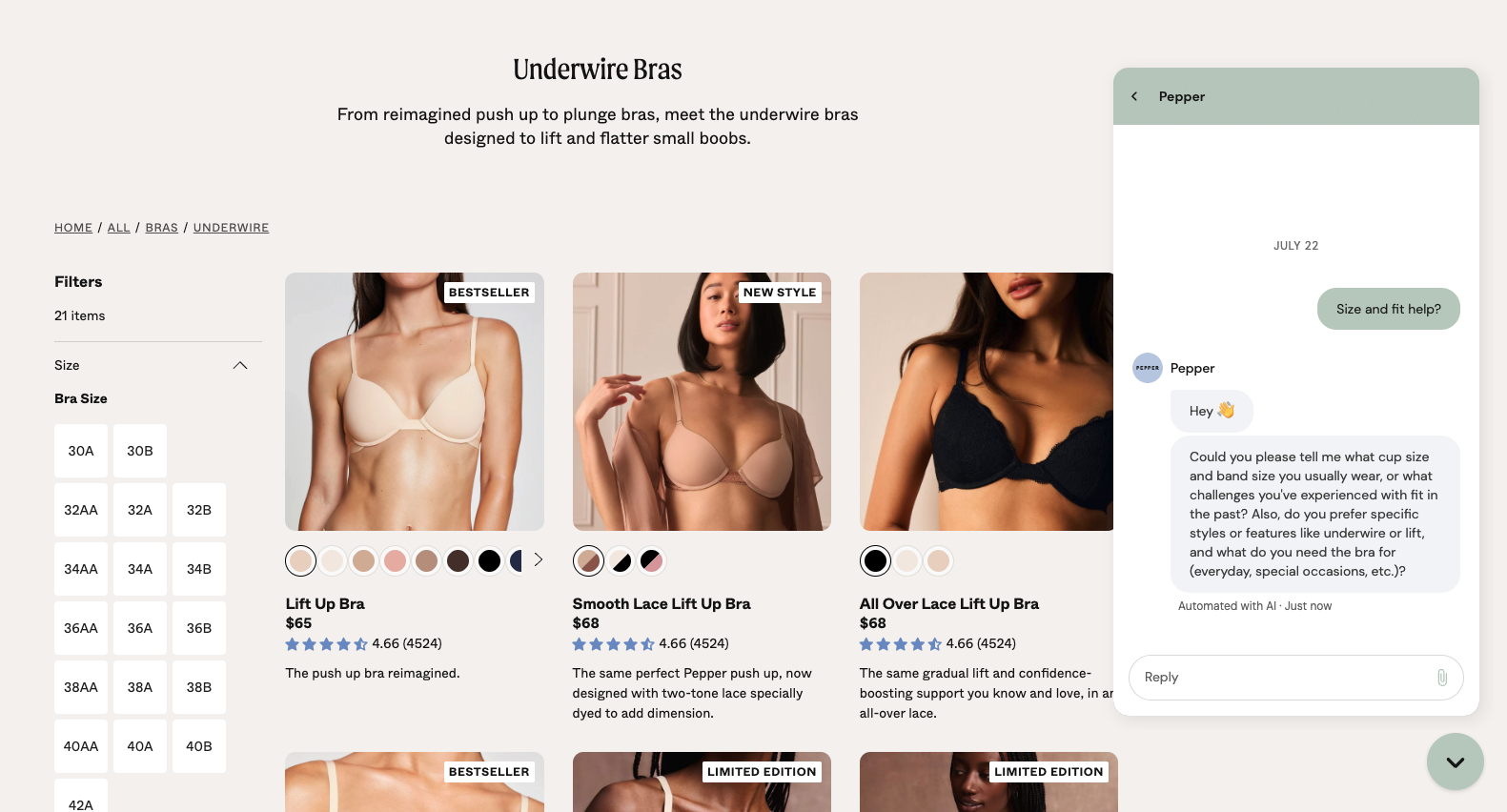
Impact these metrics 📈
For shoppers in the Discovery stage, using a Shopping Assistant boosts clicks and time on site and reduces bounce rate. It does this by surfacing specific questions on relevant product pages. Pepper boosted their conversion rate by 19% with Gorgias Shopping Assistant.
Read more: How Pepper’s AI Agent automates 54% of support and converts 19% of conversations
2) Interested (considering making a purchase)
In a retail environment, a salesperson can give shoppers recommendations by asking a few questions, especially if they’re unsure of what to buy.
AI shopping assistants have the ability to mirror those in-person shopping experiences by interacting with customers in real-time to help them find their perfect match.
Shoppers can give as much (e.g., “Help! What dress is suitable for a wedding reception?”) or as little information as they’d like, and the AI shopping assistant will do the rest.
It’s possible even for questions that are slightly vague, like a customer who types in “how to make up” without any other context:

For example, jewelry shop Caitlyn Minimalist uses Shopping Assistant to recommend products, engaging interested customers and bringing them closer to a purchase.
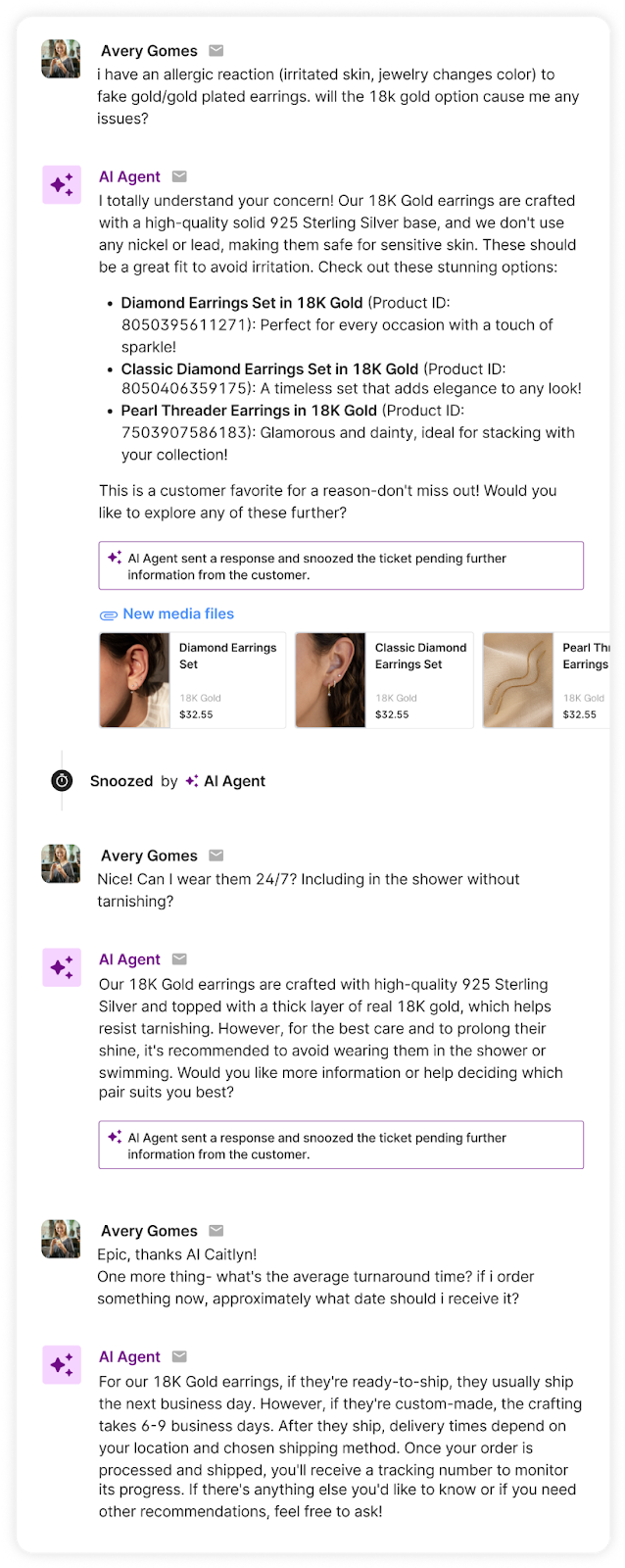
“As a result of Shopping Assistant, we've seen a measurable lift in AOV through more meaningful customer interactions,” says Anthony Ponce, Head of Customer Experience at Caitlyn Minimalist.
“Our clients are provided the right information at the right time, creating a seamless experience that builds trust and drives confident purchases."
Impact these metrics 📈
According to data from Gorgias, email is the highest volume support channel, with ~25% of that tied to pre-sales. AI shopping assistants tackle these pre-sales asks and also upsell by recommending complementary products. This can lead to a boost in average order value (AOV) and conversion rate.
Read more: How Caitlyn Minimalist uses Shopping Assistant to turn single purchases into jewelry collections
3) Ready to buy (strong purchase intent)
The main reasons customers abandoned a cart in 2025 include:
- Extra costs (like shipping, fees, taxes) - 39%
- Delivery times were too slow - 21%
- Checkout was too complicated or long - 18%
- Didn’t like return policy - 15%
An AI shopping assistant can mitigate or resolve these issues. They resolve crucial questions—like delivery time or return policies—that need in-the-moment answers. By alleviating pre-sale concerns, they give customers the confidence to make a purchase.
For example, bidet brand TUSHY leverages Shopping Assistant to answer questions about toilet compatibility that might flush a pending sale.
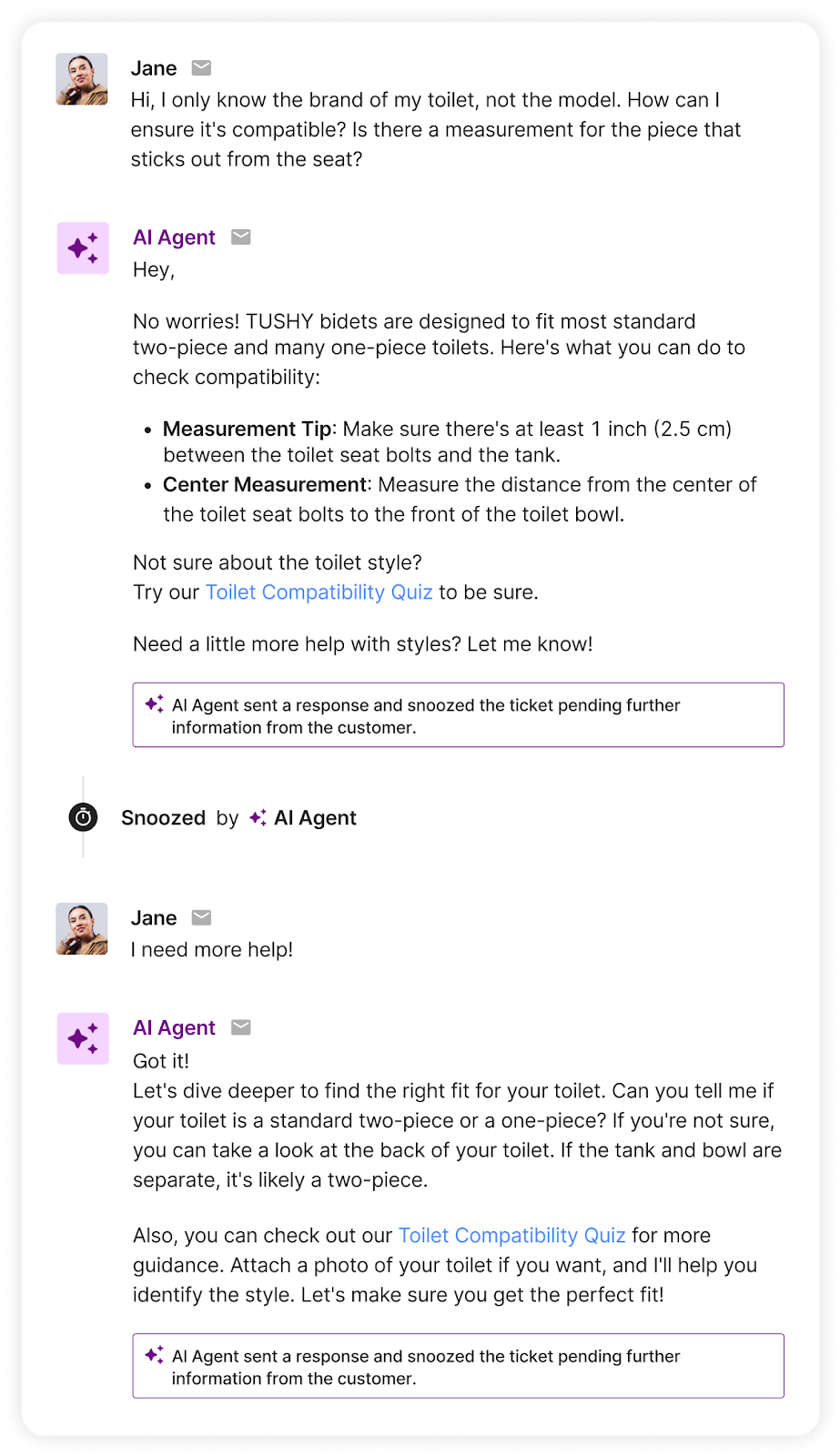
Aside from quelling customer concerns, Shopping Assistant can also send discount codes to close deals. Unlike general discount codes you find across the internet, these discounts are uniquely generated for each customer, keeping them engaged and on your site.
Impact these metrics 📈
AI shopping assistants can reduce cart abandonment rate and increase conversion rate. Gorgias Shopping Assistant adjusts to your sales strategy by sending customers discount codes that can be the final nudge to checkout.
Why traditional chatbots don’t cut it anymore
Most AI tools are built just for support. They deflect tickets and answer FAQs, but they’re not built to sell.
Shopping Assistant proves that support teams can also drive revenue by upselling, suggesting exchanges, and giving shoppers the confidence to try a brand for the first time (or to give it another shot).
Gorgias’s AI Shopping Assistant uses context-based decision making and looks for specific behavioral signals:
- Products viewed - Which product pages have they visited?
- Pages views - What pages have they explored, like FAQs, reviews or categories?
- Current page - Which page are they currently browsing?
- Purchase history – What have they bought from this brand before?
- Cart data - What items are currently in their cart?
|
Feature |
Traditional Chatbot |
AI Shopping Assistant |
|---|---|---|
|
Deflect tickets |
✅ |
✅ |
|
Answer frequently asked questions |
✅ |
✅ |
|
Upselling |
❌ |
✅ |
|
Proactively reaching out to offer support |
❌ |
✅ |
|
Use context-based signals to guide shoppers to checkout |
❌ |
✅ |
Improve conversions with Gorgias Shopping Assistant
Ultimately, the cost of not adopting AI can be higher than the investment of implementing it. 77.2% of ecommerce professionals use AI to improve their work. Why not extend those benefits to your customers?
AI Shopping Assistants help you create better customer experiences overall. These tools help reduce customer effort, increase average order value, save would-be-lost sales, and create more customer touchpoints.
Hire the always-on Shopping Assistant that never misses a sale.
{{lead-magnet-1}}
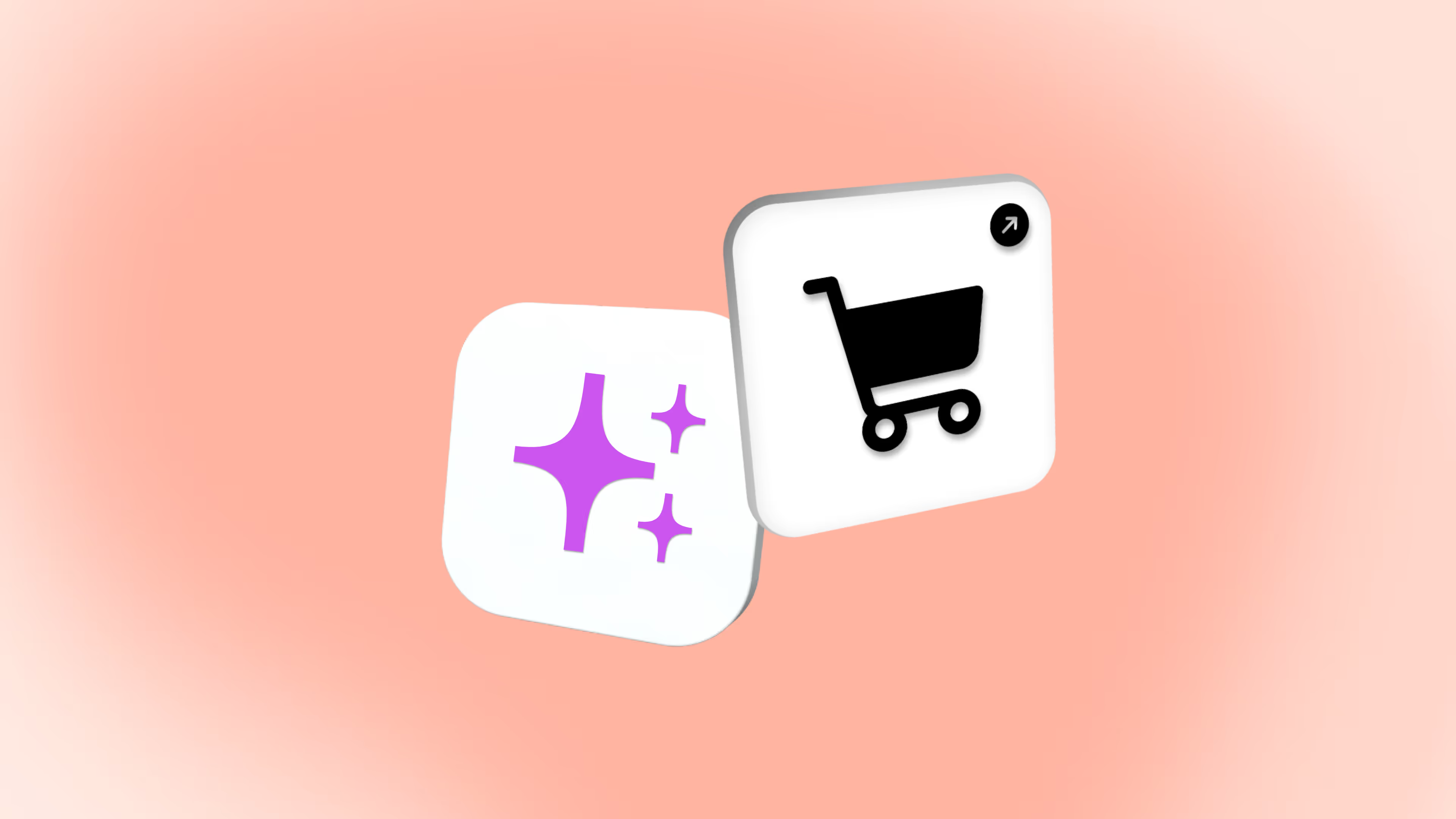
Guide More Shoppers to Checkout with Conversation-Led AI
TL;DR:
- Shopping Assistant is your new AI sales closer. It jumps in when shoppers hesitate, delivering real-time, personalized support that drives conversions.
- It boosts revenue by acting like your best salesperson. It knows when to recommend, upsell, or offer a discount, without being pushy.
- It remembers what shoppers do mid-session. That means smarter conversations, better suggestions, and bigger order values.
- It’s already delivering results. Brands using Shopping Assistant are seeing 62% more conversions, 10% higher AOV, and 5x ROI.
- You control the strategy. Customize how it promotes discounts, when it steps in, and how it speaks.
What’s the common factor between shoppers debating between products and considering a splurge? Hesitation.
Today’s shoppers are overwhelmed with choices. They don’t want to be left to figure things out on their own. They want guidance.
But most brands are missing that crucial piece of the puzzle. They lack a strategy that accompanies shoppers on their journey. A tool that encourages shoppers to proceed to checkout. And, ultimately, a customer experience devoid of a sales approach.
That’s why we built Shopping Assistant, an AI Agent that proactively engages browsers, offers context-aware product recommendations, and turns hesitation into conversions in real time.
And it’s working. Brands using Shopping Assistant are seeing a 62% uplift in conversion, 10% higher average order value, and 5x ROI.
Here’s a closer look at what’s behind the magic.
AI-powered shopping, built for sales
Most traditional chatbots passively wait for questions and deliver answers that aren’t personalized to each shopper's preferences.
Unlike these bots, Shopping Assistant reads real-time signals like pages viewed, cart contents, and conversation tone. This results in a solution that not only offers support but also offers personalized, proactive selling. This enables Shopping Assistant to continuously refine and adjust its playbook, evolving with each shopper as their journey matures.
Here’s how Shopping Assistant engages with customers across the shopping journey:
- Discovery: Gathers preferences and educates.
- Interested: Makes targeted product suggestions.
- Ready to Buy: Assists with checkout, nudges purchases with discounts.
Take this example below. When a customer vaguely asks “how to make up,” Shopping Assistant interprets it as a sign of interest in makeup products and recommends a starter kit.
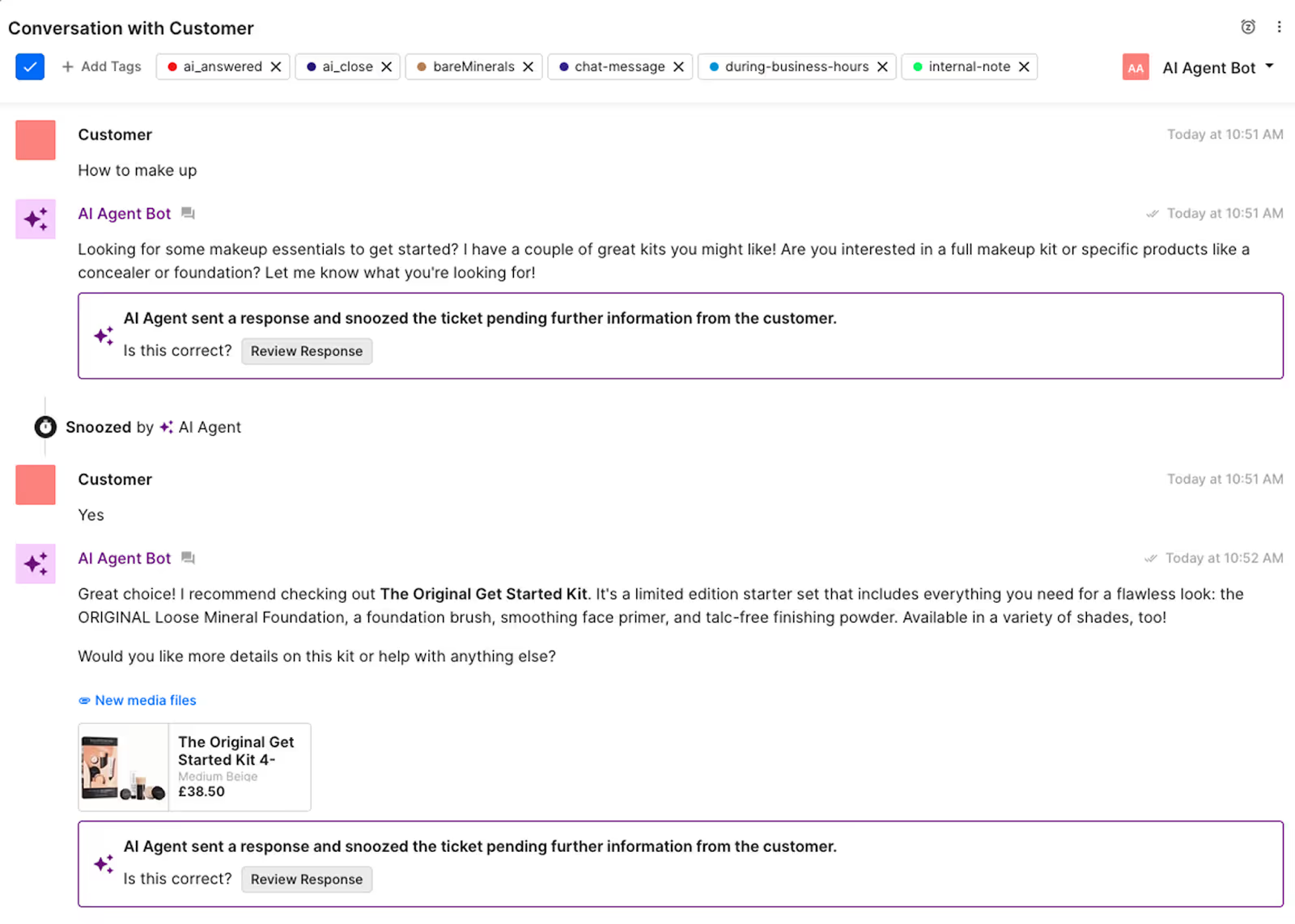
Personalization that understands you
Where traditional bots reset with every message, Shopping Assistant does the opposite. It has built-in context-aware intelligence that remembers what shoppers have clicked, viewed, and added to their cart during a session.
This enables natural, relevant, and persuasive conversations that truly resonate with each shopper. It goes beyond reading messages and observes behavior to adapt its responses.
That means it knows if someone has:
- Viewed three red lipsticks but didn’t add to cart
- Repeatedly checked sizing info for the same dress
- Added two serums to their cart after browsing dry skin FAQs
With plenty of context to work with, Shopping Assistant is not only smarter but also more profitable than the average chatbot. It drives more conversions with product recommendations and lifts average order value with timely upsells based on what’s been added to the cart or viewed.
Here’s what it looks like in action: When a customer engages through a product page, Shopping Assistant recommends a matching outfit, suggesting it’s aware of alternate product variants and the customer's likely interest in that style.
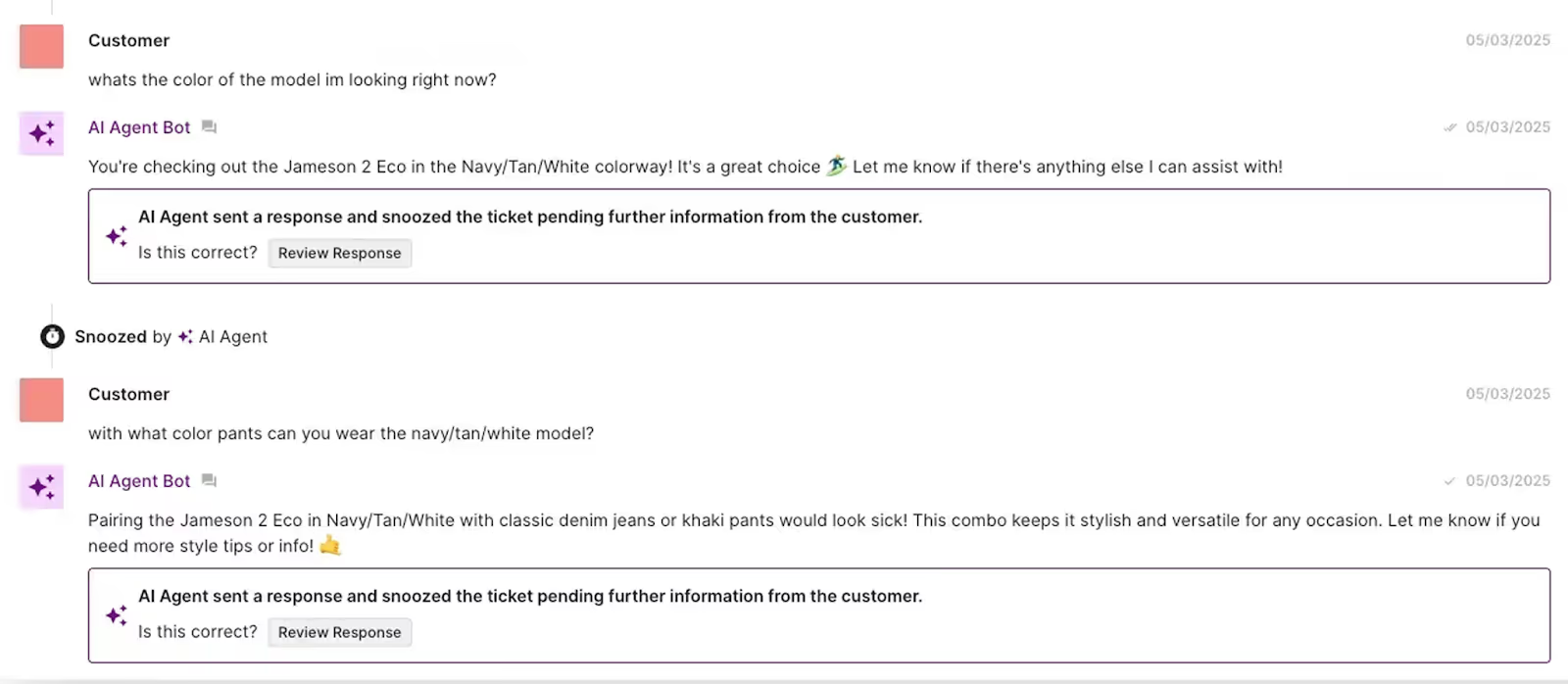
Dynamic discounts that convert without undercutting
Promotions are powerful, but they’re not one-size-fits-all.
With Shopping Assistant, merchants can define their discount strategy to align with their brand. These strategies can range from offering no deals to using aggressive promotions.
Once the strategy is set, Shopping Assistant waits for hesitation and customer intent to trigger a discount, firing it at the most conversion-worthy moment.
Proactive engagement in 3 ways
Shopping Assistant initiates conversations. It’s built to engage shoppers, spotting when they linger or show signs of confusion, stepping in with timely, personalized help.
Every second counts in ecommerce. If a shopper pauses on a product page or is left scrolling through an endless search results page, Shopping Assistant detects it in real-time and reaches out with a relevant prompt like:
- “Need help picking the right shade?”
- “Want to know our return policy before you buy?”
Here’s how Shopping Assistant reduces drop-off, builds confidence, and drives faster decision-making in three different ways.
1. Suggested product questions
Shopping Assistant automatically triggers commonly asked questions depending on the product currently being viewed. In one click, shoppers can get the answer to the question they’re curious about. This combats hesitation caused by a lack of information, resulting in more confident conversions.
2. Ask Anything Input
When shoppers land on the homepage, it’s easy to become overwhelmed and not know where to navigate. The Ask Anything Input provides an easy way to start a conversation with Shopping Assistant and get the guidance they need.
Shopping Assistant can refine its response to the customer based on the page context. For example, when the customer is on a product page, Shopping Assistant knows exactly what product is being asked about.
3. Trigger on Search
Shopping Assistant can step in to offer pinpointed help based on a shopper’s search query. Instead of scrolling through a results page, Shopping Assistant triggers a message based on what the shopper entered, offering an easier and faster way to find what they need.
Smart recommendations and relevant upsells
Shopping Assistant’s suggestions are rooted in real context: what the shopper has viewed, added to cart, or asked about. Whether they’re exploring a specific product line or revisiting a category they’ve shown interest in, Shopping Assistant delivers relevant upsells and complementary items that make sense for the customer.
This personalized approach to upselling increases cart size without feeling forced—it’s smart, seamless, and sales-driven.
Shopping Assistant can even turn vague product questions into upsell opportunities. By asking questions, it learns more about an individual to come up with recommendations that best fit their preferences.
Try Shopping Assistant today
Shopping Assistant is transforming the way shoppers engage and helping ecommerce brands sell more effectively. Through smarter conversations and real-time personalization, it turns every interaction into an opportunity to convert, build trust, and drive revenue.
{{lead-magnet-1}}
Further reading

Live Statistics for teams who want to perform
Do you switch multiple screens and views to understand what’s going on with your team? If you do, we’re happy to report that there is now a shortcut. 🪄 Live Statistics on Gorgias is your destination to get a quick overview of ticket volume, agent activity and active channels in real-time.
Where is it?
It’s up top! Once you navigate to Statistics, you will see Live Statistics conveniently placed at the top. Click on Overview to see a snapshot of all customer support activity over all channels and agents.

Ok, what am I looking at?
In Live Overview, you will see the number of Agents Online and offline. Next to these, you will find the numbers of Open Tickets in two sections (to indicate whether they’re assigned or unassigned).

Pro tip: Hover over the tooltip to see a quick list of the actual agents who are online and offline. ⬇️

Consider the number of Agents Online compared to Open Tickets
Say it’s late afternoon and you’re seeing a spike in open tickets. In Live Overview, you read 60 Open Tickets, and only 2 Agents Online. → 30 tickets per person 😱
With this information, you can immediately make decisions and take action on how to handle the higher volume your team is experiencing. For example, you may consider:
• Going to Live Agents Statistics to see the number of Chat tickets
• Creating a macro and a rule for your Chat customers who are waiting for longer than 1 minute ⌛️
• Creating a macro and a rule to set expectations around the delay
• Check internally to see if there is a problem with your delivery ops
• Stepping in to answer tickets with the Urgent tag
Knowing exactly what’s going on as it happens live, later observing fluctuations in First Response Time or Resolution Time won’t catch you by surprise. You can make a better assessment on your team’s performance by being fully aware of the circumstances around your metrics.
In Live Statistics, we simplify and organize information so you can be fully aware without needing to contact your team personally or be physically there.
Monitor Support Volume live
In Live Overview, you will see a nice graph to inform you on the hourly Support Volume. Use this graph to see how your team is responding to inquiries as they emerge.

Looking at this graph, you can quickly grasp the volume you’re getting by the number of Tickets Created, Tickets Replied and Tickets Closed separately, but on the same timeline so you can compare.
Observe when Tickets Created see a spike, compare it to Tickets Replied
When do you receive the bulk of inquiries? Does it happen before business hours?

You can see above an example where a lot of customers decided to contact the support team throughout the night. As a manager, you can monitor to see if this is a consistent pattern over time, and develop strategies on the support and operations side to improve experience. Looking at this graph, and seeing this type of pattern, you may want to ask:
• Are these tickets urgent? Are we properly auto-tagging to identify urgency?
• Are my agents ready to tackle this ticket volume at the beginning of their shift?
• Are these tickets auto-assigned?
• If these inquiries are urgent, should we set autoresponders?
• Is it worth getting additional staffing or how can I leverage self-service?
Monitoring the Support Volume graph, you can start to detect patterns that are connected to the entire customer experience. Anticipating problems or delays before they can occur, you can take measures to improve CSAT despite the predicaments due to international shipping challenges or a mix-up on a batch of orders etc. You can use the visibility and insights from Live Statistics to inform your overall operations.
Live means real-time
Live Statistics is designed to inform you on an hourly basis. It gathers the right metrics and combines them strategically so you can get the right information and react quickly without being there.
All metrics in Live Statistics reflect your current day from 12:00 am to 11:59 pm in your time zone. If you need to change the time zone, you can easily do this in Business Hours under Settings.
Who is working?
In Live Agents, you will see whether each team member is currently online or offline, indicated by a green dot if they’re online - 💪 working away, or an orange dot indicating that 💤 they’re offline.

Pro Tip: Hover over these dots to see when they signed in (on the green dot), and when they were last seen that day (on the orange dot).

Live Agents Statistics will show you the exact amount of time each team member has been online in hours and minutes (e.g. 2h 6m). On this table, you will also see the number of Tickets Closed and Messages Sent. The ability to see this exact combination of data per agent will really help you monitor your team’s efficiency and know which agents to coach to improve performance.

Have all of your team use this, so everyone can self-check 🩺 and have their sense of achievement for the day based on data - 😉 not just feelings. Reviewing Live Statistics as a team, you can collaborate to come up with effective strategies to reduce the rate of messages sent per ticket closed.
Who is working on what?
Located in the far right column, Open Tickets 🤩 feature makes Live Statistics whole. This is where you can clearly see who’s working on what. You can see the total number of open tickets currently being helped by each team member. Placed immediately next to this number is the breakdown by channel.

You can read above how Jenny has 15 open tickets, with 3 from Chat, 7 from Email, 3 from Facebook and 2 from Instagram.
Click on this number to see just exactly what Jenny’s working on. Each of the numbers provided under Open Tickets, the total and by channel, is clickable and it will bring you to a readily filtered view where you can take a closer look at what your agent has at hand.
This experience will help you review your team’s activity in microscopic detail as you desire, without needing to interfere or navigate to different Views.
Help your team on the spot
Check out the full combination of Online Time, Tickets Closed, Messages Sent and Open Tickets. Let’s bring back Jenny and look closer to see that she has 3 Tickets Closed, 12 Messages Sent and 15 Open Tickets. Under Online Time, it reads 6h 12m so she is approaching the end of her shift.

Right away, we can notice that she’s approaching the end of her shift with a lot (15) more tickets to go. There’s no need to get alarmed, but it’s better to take a quick look at what’s going on. Clicking on the number listed under Open Tickets, we can easily review the tickets she’s working on. Taking a quick look at her tickets, we notice a shipping problem on multiple orders - all large items shipping internationally with a third party. Knowing Jenny’s not familiar with third party shipping, we can remove these tickets from Jenny’s queue and make sure that we mark our calendar to train her on this topic before BFCM hits. ✅
All of these features in Live Statistics, Overview and Agents are designed to give you full visibility and control so you can take timely action to remove stress from work and from your team. 😅
Still waiting to give it a try? Go to Live Statistics now ➡️
📞 Let’s get on a call to have a quick chat.
✏️ We love hearing your insights, please drop us a note here.

7 new apps that integrate with Gorgias
Gorgias connects to over 70 leading ecommerce applications, giving you the power to centralize customer data in your helpdesk, perform support actions from a single place, and streamline your store’s toolkit.
This month, we launched 7 new integrations:
- LoyaltyLion
- Twitter (No longer supported in 2023)
- Call Hippo
- Shipup
- Tolstoy
- Autopilot
- Sentisum
- Yotpo (updates to our existing integration)
Read on to learn how you can use these tools to help manage your store, and visit the Gorgias App Store to activate them today!
1. LoyaltyLion
LoyaltyLion is a digital loyalty framework that gives ecommerce stores innovative ways to engage and retain customers. If you're using LoyaltyLion for your loyalty program, you can connect it to Gorgias to display information next to support tickets, and reward loyalty points using Macros.

2. Twitter
Note: Gorgias no longer supports Twitter. You can still use Facebook, Instagram, and WhatsApp in Gorgias.
Give your support team the power to provide customer service to shoppers on Twitter, without having to log into another platform or share credentials with your social media manager. View past Twitter conversations, gain cross-channel message context, and customize your replies to provide exceptional customer support.
Note: This integration is currently only available for Enterprise plans. View pricing here.

3. Call Hippo
CallHippo allows startups and businesses to buy instant local support numbers from over 50+ countries around the world. With this integration, you can create tickets in Gorgias for phone calls and SMS conversations via Call Hippo.

4. ShipUp
Shipup follows your packages in real-time to create a seamless, transparent, and branded delivery experience. With the Gorgias integration, you can easily share shipping information with your support team, immediately notify them with a ticket in Gorgias when an incident occurs, and find customer information right next to conversations.

5. Tolstoy
Tolstoy is an interactive video platform, helping users create meaningful and personal conversations at scale. With this integration, Gorgias users can sync their Tolstoy videos and monitor every viewer interaction as a ticket, empowering support agents to engage without ever leaving the help desk.

6. Autopilot
Autopilot is a data and customer journey marketing platform designed for businesses who sell online. With this integration, you can now combine your Shopify and Gorgias data together seamlessly in Autopilot. You’ll not only have a single view of your customer, but you’ll be able to deliver a more personalized marketing experience and get glowing reviews from satisfied customers.

7. SentiSum
SentiSum is an automated ticket tagging engine powered by natural language processing technology. With this integration, SentiSum tags can auto-fill form fields directly in Gorgias. From there, you can implement additional automation that saves agent time and improves customer outcomes.

8. Yotpo
You can now receive Yotpo product reviews right in Gorgias and reply to them as tickets! This gives your agents visibility into how shoppers feel about your product and allows them to address concerns without ever leaving the helpdesk. Each ticket will include the review details (like score and product) and allow you to either reply publicly or privately, so you can customize the support experience.

To add these integrations and discover more, go to the Gorgias App Store.

Top 10 Integrations Used by Gorgias Ecommerce Merchants
Have you ever wondered how other leading ecommerce stores manage customer support, especially when they are using Gorgias? We love identifying these trends and wanted to see what integrations have been the most useful in our customers' ecommerce tech stacks so far.
In order to help you bring all your customer data in one place and offer truly exceptional, personalized support, here are the top 10 integrations being used by Gorgias customers:
- Email, specifically Gmail
- Gorgias Chat
- Facebook and Instagram
- SMS apps
- Klaviyo
- Recharge
- Phone, either our native solution or Aircall
- Yotpo
- Smile
- ChannelReply
1. Email, specifically Gmail
If you've been worried that email is becoming obsolete in the age of chat boxes and SMS support, don't be. Email is the leading support channel on Gorgias, used by 67% of customers.
This make sense. While faster, more instantaneous methods of communications are becoming common, email is still the primary channel to answer complicated support questions and send transactional messages like shipping updates, return logistics, and order/cancellation confirmations.
Of email integrations, Gmail is the leading provider with 59% of Gorgias customers having it active.
To learn more about our Gmail integration, click here.
2. Gorgias chat
Chat support is the second most common channel we see our merchants using, in order to offer real-time communication in addition to traditional emails or tickets. And thanks to our native chat integrations, it's easier than ever to launch a chat widget on your website.
57% of Gorgias merchants use our native chat integrations to offer real-time support.

This allows your shoppers to talk to an agent faster, but also presents a great opportunity to implement self-service options so they can help themselves. (Our Self-Service Chat Portal can help with that!)
3. Facebook and Instagram
Managing inquiries on social media and gaining insights into the conversations happening in those communities is te next priority for our merchants.
Over 50% of Gorgias brands are integrated with Facebook and/or Instagram.
Our Facebook integrations (which also includes Instagram) allows you to manage messages, comments, ad comments, and mentions as tickets in Gorgias. This gives your agents visibility into every conversation no matter where it happens, and empowers them to reply directly to shoppers without having to log into separate platforms or coordinate with your brand's social media team.
"The Gorgias-Facebook-Shopify integration is amazing. We've stopped hunting and matching Facebook users to customer accounts on Shopify. The information we need is surfaced so we can respond better and faster. Gorgias allows us to operate both ecommerce and social commerce business seamlessly." - Guita Gopalan, Chief Revenue Officer at Ellana
Nervous about the quantity of tickets that would be created from integrating social channels with Gorgias? Don't be. You can use Rules to filter out comments your team doesn't need to worry about (like comments that only consist of emojis), or even auto-assign tickets to specify agents/teams so no one has to triage the requests.
4. SMS apps
Text message marketing has become an incredible revenue generator for ecommerce brands, but it also opens another new communication channel with your customers: SMS.
In order to make the most of SMS as a marketing tool, you also need to be ready to support it when customers reply back with questions. That's where Gorgias comes in; we integrate with SMS apps to help you connect your agents with shoppers sooner and collect all customer conversations in one place.
Over 23% of Gorgias customers are integrated with an SMS tool.
The top SMS apps connected to Gorgias are:
- Attentive, used by 10% of merchants
- Postscript, used by 8% of merchants
- SMS Bump, used by 5% of merchants
"Working with Postscript and Gorgias gave us the leverage to keep customers close to deliver the best possible customer experience. It is super helpful to have a full view of the customer, all in one-spot." -Eli Weiss, Director of CX at OLIPOP
5. Klaviyo
The next app on our list will help you collaborate with your marketing team to create a best-in-class shopper experience, whether they are interacting with the support team or receiving the latest promotion.
Klaviyo is an email and SMS marketing app for businesses that sell online. Our integration connects the two platforms, allowing you to use the data to create better campaigns.

17% of Gorgias merchants are integrated with Klaviyo.
With this integration, you can push Gorgias events into Klaviyo for advances and customer-centric email segmenting.
For example, here are some of the ways we've seen customers use the two tools together:
- Promoting sales or new products to customers who had positive support experiences to drive upsell and revenue generation from support.
- Excluding customers with open support tickets from promotional messaging campaigns.
- Sending target coupons or discounts to win back customers who reported poor support experiences.
You can learn more about our Klaviyo integration or activate it here.
6. Recharge
The most common integration will help with subscription management, which is probably no surprise: Even with a great payment platform, subscription questions and transactions tend to result in a lot of support requests.
Recharge us a subscription and recurring payment platform for ecommerce sites, and helps you turn transactions into relationships.
15% of Gorgias merchants are integrated with Recharge.
Connect Gorgias and ReCharge for a simple way to manage customer subscriptions and customer service from one convenient location.
When you integrate Gorgias and Recharge, you can:
- Display ReCharge subscriptions next to support tickets in Gorgias, to gather full customer context before replying to questions.
- Cancel subscriptions, re-activate subscriptions, or refund a charge (either partially or totally) right from the Gorgias helpdesk.
- Embed ReCharge data in your Macro replies to automate the most common support questions.
Click here to learn more about our Recharge integration.
7. Phone, either our native solution or Aircall
It's clear that digital support is the first priority for most of our merchants, as seen by email, chat, and social media being the top three integrations on our list.
Sometimes it's nice to have a real conversation with your customers, however, which is why phone integrations are next.

12% of merchants offer phone support.
Many use our Aircall integration, which is great if you need the advanced feature a dedicated tool like Aircall provides. If you're just adding phones for the first time, we released a native phone integration this year that's helping merchants begin to offer voice support.
8. Yotpo
Beyond answering customer questions, your support team may want to engage with reviews from shoppers in order to address issues, win back unhappy customers, and interact with your biggest fans!
Yotpo, a platform for ecommerce marketing and reviews, is great for this.
Over 8% of Gorgias merchants have activated our Yotpo integration.
The integration allows you to:
- Display customer's Yotpo data un Gorgias customer Activity Sidebar such as loyalty points, provided ratings, latest reviews, etc.
- Manage customer loyalty plans (change point balance, assign VIP tier, honor redemptions, and send rewards) from the Gorgias sidebar.
- Respond to a question with an answer either publicly or privately as new tickets.
- Moderate customer reviews (product and site) and questions from within Gorgias as new tickets.
- Request reviews from a customer.
Click here to learn more about our Yotpo integration and activate it.
9. Smile
No one knows your shoppers quite like your support team, which makes an integration with a loyalty app a natural fit! Smile.io is a favorite of Gorgias merchants, which helps you manage a reward program and build strong relationships with your newest and most loyal customers.
6% of Gorgias merchants integrate with Smile.io.
With this integration, you'll be able to see customer loyalty information right next to tickets in Gorgias, so every agent knows when they are talking to a new customer or one of your VIPs! You can also use this information to help triage tickets or separate ticket views by loyalty status (which is great for managing different levels of support SLAs).

To learn more about our integration with Smile.io and activate it for your account, click here.
10. ChannelReply
If your shop sells on public marketplaces beyond your own Shopify store, the final app on our list is a must. ChannelReply helps you manage messages from Amazon, eBay, and Walmart.
With our integration, you can then manage all those messages right from your helpdesk, eliminating the need for your agents to open different browser tabs for each platform.
Over 5% of Gorgias merchants use the ChannelReply integrations.
To learn more about ChannelReply and activate the integration for your account, click here.
And there you have it: The top 10 integrations with Gorgias in 2021! We hope this helps inspire you how you can use your helpdesk to offer exceptional, conceptual support and how to streamline the tools your store uses everyday to grow your business.
To get more ecommerce tool suggestions, check out our list of 150+ great tools. And to view all integrations with our platform, visit the Gorgias App Store.

12 New Apps That Integrates With Gorgias
Gorgias connects to over 65 leading ecommerce applications, giving you the power to centralize customer data in your helpdesk, perform support actions from a single place, and streamline your store’s toolkit.
This month, we launched 12 new integrations:
- SMS Live
- Checkout Champ
- CallHippo
- Konnektive
- TXTFi
- Shopney
- ReturnLogic
- Stateset
- Gatsby
- Trustpilot
- ShipBob
- AfterShip
Read on to learn how you can use these tools to help manage your store, and visit the Gorgias App Store to activate them today!
1. SMS Live
SMS Live is an SMS texting app for Shopify and Shopify Plus. When you add this integration, you’ll see customer information from SMS Live in the Gorgias sidebar, so your agents don’t have to switch between the two applications. You’ll also be able to respond to SMS messages within the Gorgias helpdesk or switch those conversations to a different channel, such as email or phone.

2. Checkout Champ
Checkout Champ simplifies the checkout process and makes it easy to charge for subscription services or one-click upsells. With the Gorgias integration, you can manage all of your customer interactions to include refunds, fulfillment tracking, purchase alterations, and all messaging and tickets.

3. Konnektive
Konnektive is a cloud-based CRM and order management solution that helps optimize, centralize, and automate ecommerce business processes. With this integration, you can display order information right next to tickets in Gorgias and update customer information between the two platforms. It automatically comes with 10 pre-built Macros, to help you get started right away!

4. TXTFi
TXTFi allows brands to leverage purchasing through SMS and ensures side-by-side customer support to communicate with customers in real time. With this integration, you can manage SMS conversations from TXTFi as tickets in Gorgias in order to quickly connect your shoppers with a live agent.

5. Shopney
Shopney is a mobile app builder for Shopify and Shopify Plus that lets you build an app for your store in just one day. With this integration, the conversations that happen through Shopney’s in-app live chat can be managed in the Gorgias helpdesk for a streamlined experience for your agents.

6. ReturnLogic
ReturnLogic helps D2C brands give their customers an easy returns process while automating workflows for their customer service and warehouse teams. With the Gorgias integration, you can embed the Gorgias Chat Box right on the ReturnLogic portal, giving shoppers another opportunity to make their return, exchange, or warranty process as smooth as possible. You can also manage these chat conversations in Gorgias and populate ReturnLogic data into Gorgias tickets.

7. Stateset
Stateset is your single source of truth for managing your online business and automating your commerce operations. The Stateset AI Responder app uses state-of-the-art artificial intelligence and robotic process automation to quickly and accurately build data-driven responses ready for your customer service team to approve. When you connect the Gorgias integration, you can start generating intelligent and dynamic responses directly from Gorgias or from within Shopify.

8. Gatsby
See Instagram insights when responding to tickets, track Instagram mentions and engagement for your brand, and automate valuable influencer workflows all in Gorgias.
With the Gorgias and Gatsby integration, you can now identify when influential customers are reaching out for support and take that into account when prioritizing tickets, asking them to share positive support experiences and more.

9. Trustpilot Reviews
Trustpilot Reviews is a customer review platform. With the Gorgias integration, you can streamline review responses with machine learning and AI. Trustpilot Review data is displayed in the Gorgias Customer Sidebar, ready to be leveraged by agents to reward happy customers and help recover customers at risk of churn.

10. ShipBob
ShipBob is an ecommerce fulfillment solution for online brands. With the Gorgias integration, you can sync customer and order information associated with a specific ShipBob account into the corresponding Gorgias account. You can also display data from ShipBob in the Customer Sidebar, and use that data in Gorgias Macros to automate responses to common claims.

11. AfterShip
AfterShip is an automated shipment tracking platform for e-commerce businesses. With the Gorgias integration, you can sync and display all customer shipment tracking data in the Customer Sidebar, allowing your agents to quickly answer questions without switching applications.

To add these integrations and discover more, go to the Gorgias App Store.

10 Rules to Help You Efficiently Manage Instagram Interactions on Gorgias
Instagram is really the perfect social channel for Ecommerce brands. You can show off your products, share user-generated content, and engage with your community to build brand loyalty.
All that engagement is great, except it adds a task to your plate that quickly multiplies as your brand grows: You have to interact back. Or at least you should, if you want to capitalize on all that engagement!
Sometimes your marketing team or social media manager will handle Instagram replies, but sooner or later you’ll start to get the “Where is my order?” (or “WISMO”) question from shoppers, regardless of the content being shared. This can result in an inefficient workflow between social and support teams to communicate the question, track down an order status, and get a reply back to the customer.
That’s why Gorgias integrates directly with Instagram (and other social media platforms), to streamline the management and interaction with top-level comments, ad comments, private messages, and replies. Instead of going back and forth between your Ecommerce platform, the social team, and the support team, you can empower your agents to reply quickly and accurately to any question that comes in, thanks to over 50+ integrations with the leading Ecommerce apps. (So all the context they need will be in one single browser tab!)
You could even have your marketing team or social media manager help create Macros, so your support agents can use templated (and on brand) messages that speed up their replies. Getting everything centralized in a single place is the first step to providing excellent social support for your store. The next is to start automating replies to common engagements, so you can free up your agents to focus on more important conversations instead of saying “Thanks for the mention!” for the hundredth time.
To help your store start managing Instagram support more efficiently, I’ve collected a list of Rules that Gorgias customers are using to engage with their shoppers, resolve questions faster, and keep their agents focused on the most important conversations.
Here are 10 Rule ideas for more efficient Instagram support:
- Auto-close tickets from giveaway posts
- Auto-close all Instagram tickets
- Auto-tag all Instagram interactions
- Auto-tag likely buyers & create a specialized view
- Auto-tag interactions from influencers for VIP support
- Auto-tag public comments vs private messages
- Auto-tag Instagram tickets with questions
- Auto-close Instagram tickets the don’t mention support or order status
- Auto-tag negative comments
- Auto-assign Instagram tickets to an agent or team
1. Auto-close tickets from giveaway posts
Giveaway posts are great for brand awareness, but can also result in a large increase in tickets in your help desk. To stop this from ever becoming a problem, you can set up a Rule to auto-close tickets generated from giveaway posts, based on the message content.

In this example, we’re auto-closing tickets without the words “who,” “what,” “when,” “where,” “why,” and “how,” in order to avoid accidentally closing an actual question that your team might want to respond to. You could also customize this to close tickets that include a specific word or phrase, based on the criteria of the giveaway. I recommend working closely with your social media manager whenever a new promotion starts, to make sure your helpdesk is set up to triage tickets accordingly.
2. Auto-close all Instagram tickets
If you want to see Instagram engagements in a contact’s message history, but not necessarily respond to them from Gorgias yet, you can auto-close any ticket generated from Instagram, that way it doesn’t fill up the open queue.

By doing this, your agents will have the full cross-channel message history when interacting with a shopper, so they can customize the conversation and know exactly what they’ve asked in the past.
3. Auto-tag all Instagram interactions
Tagging tickets in Gorgias is a great way to measure channel statistics and create customized Views. While your agents will always have the option to manually add tags, you can create a Rule to do the tagging automatically, that way it’s one less step in their workflow.

Then when you go to Statistics > Tags, you’ll be able to see how many tickets are generated from Instagram during a given period, and what percentage that is of all the tickets you receive.
Pro-tip: If you haven’t started managing Instagram tickets in Gorgias yet because you’re not sure what exactly the ticket volume would be, you can Auto-tag and Auto-close tickets in order to see the stats without conversations counting toward your plan’s ticket count yet.
4. Auto-tag potential shoppers & create a specialized view
Prioritize the messages and comments from those most likely to purchase. By detecting message sentiment and filtering by common phrases, you can automatically tag tickets with a high purchase intent, allowing your agents to answer questions quickly or send along a discount code to speed up the purchase.

Once you’ve set up the Rule, you can create a View to filter tickets that only contain this tag, that way your agents can easily see right in the left-hand sidebar whenever there’s a ticket from Instagram from a likely lead!

5. Auto-tag interactions from influencers for VIP support
If you work with influencers, it’s critical to reply to them right away to maximize the impact of their community. To make sure your team never misses an opportunity, you can auto-tag tickets created from the partners you’re working with based on their email address.

Once the Rule is auto-tagging these tickets, you can also create a view to segment these messages from the others. Depending on how many partners and influencers your brand manages at a time, it may be helpful to set up one View per influencer (in which case you’d want to use separate tags), or group them all together in an “Influencers” section.
6. Auto-tag public comments vs private messages
Whenever you reply to a ticket in Gorgias, you’ll see a small icon next to the customer’s name that signals what channel you’re replying on. If you want some extra assurance that your reps are only replying with personal details in private channels however (such as Instagram messages) you can automatically add tags to designate “public” vs “private,” so everyone can see right at the top of the ticket which type of communication it is.

7. Auto-tag Instagram tickets with questions
Prioritize interactions that are asking your brand something, instead of just commenting with emojis. If your brand receives a lot of engagement, this can help you filter out what needs to be addressed and what can likely just be closed out (or handled by the social team).

8. Auto-close Instagram tickets the don’t mention support or order status
If your support team is only interested in responding to the Instagram tickets that specifically mention customer service, you can auto-close everything else (and assume the brand team will take care of it). To do this, create a rule that closes tickets that do not include phrases like “order” “status” “support” or “customer service.”

9. Auto-tag negative interactions
Escalate the tickets that have negative intent to get them a response faster. You can add keywords (or emojis) and use our sentiment detection to auto-tag negative comments, so your agents see right away what kind of ticket they’re opening.

10. Auto-assign Instagram tickets to an agent or team
If you have a specific person who handles social media, whether that’s an agent or the social media manager, you can automatically assign tickets created via that channel to them, so those tickets never get routed to the rest of your team.

I hope these 10 Rules help you engage with your shoppers, resolve questions faster, and keep your agents focused on the most important conversations. If you haven’t connected your Gorgias account to Instagram yet, follow this guide to get started.
Alternatively, keep reading about social media for customer service, or check out our list of the best social media integrations for your Shopify store.

New integration: Manage Instagram messages from Gorgias
If your store leverages Instagram to drive sales, you know it’s important to engage with every member of your community whether they’re commenting on your posts, engaging with your Story, or sending you a message.
Over 4,000 teams on Gorgias have been using our Instagram integration to respond to (or automate responses to) mentions, comments, and ad comments. Earlier this summer, some customers were able to also start receiving and responding to Instagram messages (but it was limited to accounts with between 1,000-100,000 followers).
Today, we’re excited to share that there’s no longer a follower requirement to use Instagram messaging!
Every Gorgias customer (with a non-legacy plan) can manage Instagram messages (including Story mentions) directly from your helpdesk, allowing you to engage with your shoppers quickly and efficiently so you never miss a conversation.
Plus you’ll also be able to reply to comments with a message, giving your team the option to turn a public conversation into a 1-1 chat.

Customers who were able to start using this feature early have already replied to over 300,000 messages and Story mentions. In fact, about 2% of tickets in Gorgias are Instagram messages!
It’s clear our customers love using Instagram to engage with their communities and drive sales, which is why we’re so excited to open this channel up for all of our merchants regardless of their follower count.
Related: Our list of the best social media apps for Shopify.
To get started, you’ll need to make sure you have the "Allow Access to Messages" setting active in Instagram.
You can do this In Instagram Business Messenger by going to Settings → Privacy → Messages and setting the toggle to active.
Once that’s done, go to the Integrations tab in your Gorgias helpdesk and select “Facebook, Messenger & Instagram.”

Click the green “Reconnect” button to refresh your settings, and then you’ll be able to enable “Instagram Direct Messages” in the checkboxes.

This will connect Messages and Story mentions to Gorgias, allowing you to reply directly from the helpdesk and see previous conversation history (so your agents have all the information they need right in one place).
The following video will show you how to get started, along with some common troubleshooting tips.
If you’re managing a lot of customer support conversations on Instagram, it may be helpful to set up views for each type of interaction. For example, you could have a view for Instagram comments, another for Instagram Messages, and a third for Instagram ad comments.

You can also use Rules and Macros in Gorgias to reply even faster (or automate conversations entirely!) in order to free up your agents to focus on more important conversations.
Here are a few ideas to get you started!
1. Create a Macro sending a message to say “Thanks for the mention!”
If you have customers that love to tag your brand or products in their own posts, an easy way to continue building brand loyalty is to send a quick “thank you.” To save your agents time, you can create a Macro they can re-use anytime you get a Message that you’ve been mentioned in someone’s story or post.

2. Adding tags to track Instagram Story mentions
If you want to track how often your brand is mentioned in Instagram Stories, you can tag tickets that come in from the Messages channel with “Mentioned you” in the message body.
By creating a Rule to do this, you can automate this process so it doesn’t add any extra time or steps into your agents workflow, but gives you powerful insights.

3. Creating a Rule to auto-reply to Instagram messages outside of business hours
If you don’t want to reply to messages 24/7, it may be helpful to create an auto-response to set some expectations outside of your business hours.
You can easily do this with a Rule, and even encourage your followers to go somewhere else in the meantime, such as your website, a specific landing page, or even a partner account!

Hopefully this gives you some inspiration on how you can start using Gorgias to engage with your Instagram community without increasing the workload on your support agents. And if you're interested in messaging customers directly, check out our social media and SMS features. With social media for customer service, you can interact with customers on platforms like Instagram or Facebook. And with SMS for customer service, you can enable texting for your most on-the-go customers.
Related: Lean how Gorgias customer Berkey Filters launched SMS and drove incredible customer adoption to this new, faster channel.
To start simplifying management of your messages, comments, and mentions, get started with Gorgias and add the Instagram integration today!

It’s Official: Gorgias is Now SOC 2 Type II Certified
When you use Gorgias, we know that you’re putting your trust in us. That’s why we hold our commitment to your security as our highest priority and safeguard your data with full transparency. Our security policy contains penetration testing, incident response plan, data lifecycle, comprehensive system status live report, and more.
We're thrilled to share that Gorgias is Service Organization Control (SOC) 2 compliant for Type 2. This achievement follows our numerous investments in platform security over the years as part of our goals to secure customer data.
An independent auditor conducted a thorough audit of our servers, systems, and products over six months. They verified that our information security practices, policies, procedures, and operations meet the thorough SOC 2 standards for security.
2022 update: We're happy to share that we renewed our SOC 2 Type 2 certification to continue protecting our customer data.
This industry-wide recognition serves as our reassurance that your data is managed in a controlled and audited environment.
What is SOC 2 Type II Compliance?
Developed by the American Institute of CPAs (AICPA), SOC 2 defines criteria for evaluating how well a company manages customer data and ensuring a set of security controls are in place. A SOC 2 report is unique to each organization because it’s in line with specific business practices.

There are two types of SOC 2 reports: Type I and Type II. Type I checks if a system can handle issues like data breaches. Meanwhile, Type II examines how the system works and how effective it is to protect data against security threats.
What Does Our SOC 2 Type 2 Compliance Mean for You?
Our completion of the SOC 2 Type II audit is our testament to the fact that we always prioritize your data security and privacy. We appreciate your trust in us and strive to strengthen this trust in the long term.
You can be sure that:
- The data you share with Gorgias meets the AICPA standards for security. That goes for your personal information, ticket inquiries, customer data, and the like.
- Your data is protected with procedures and controls to assess, minimize, and eliminate risks and vulnerabilities.
- We always conduct ongoing monitoring of features and processes across our platform to maintain security.
What’s Next?
We hope our successful SOC 2 Type 2 helps you rest easy knowing that your data in Gorgias is secure. But this update is only the latest milestone in delivering our commitment. We’re continuing to improve our security control and data privacy practices for all merchants. To learn more about our security policies, visit our security page or contact us at support@gorgias.com.

Increase Retention and Reward Your Super Fans with Yotpo + Gorgias
With visibility into product reviews right in the Yotpo widget in Gorgias, your support agents will know right away if they're talking to someone who didn't love their last product, or someone who is a big fan of your brand. This knowledge will help you customize the conversation for the best experience possible.

"At OLIPOP, we’re always looking to have a holistic view of the customer to be able to offer the best possible experience. Having the ability to see their most recent reviews within the Gorgias platform is a total game-changer. " - OLIPOP, Director of Customer Experience, Eli Weiss

How to make the most of this integration
You can use Gorgias macros to quickly respond to customers that leave 5-star reviews to build brand loyalty. You can also create macros for customers who leave negative reviews to ensure their concerns are properly addressed, and send them a discount code to help rebuild trust!
By looking at the shopper's review history, your support agents can also quickly shift from just offering customer service to acting as members of the sales team. They can recommend products that are either similar to something the customer previously loved, or different than something they had a bad experience with.


"Gorgias clearly understands the needs of customer service agents, and with this new feature is working towards making all the day-to-day tools accessible from one tab, making work even more agile and with less distractions. We're particularly excited about the ability to understand customer sentiment from the get go, and how we can better approach our users based on the feelings they have shared about their past TUSHY purchases. If we see they are a super fan, we can go heavy on the butt puns, but if they've had a less than stellar experience we will aim to make up for it in our subsequent conversations, and even address things they don't directly mention! We're excited to see how this feature will help us deepen our genuine human connections. " - TUSHY, Director of Customer Experience, Ren Fuller-Wasserman


Building delightful customer interactions starts in your inbox



